Impact of Tropical Cyclones on Inhabited Areas of the SWIO Basin at Present and Future Horizons. Part 1: Overview and Observing Component of the Research Project RENOVRISK-CYCLONE
Abstract
1. Introduction
2. Structure and Objectives of RNR-CYC
2.1. Observing Component
- A three-year satellite acquisition campaign (2017–2020), set up in collaboration with ESA and IFREMER, to collect high-resolution (1 km) observations of surface winds and sea roughness from spaceborne synthetic aperture radars (SARs) deployed onboard the satellites Sentinel 1A/1B of the European Earth Observation Program Copernicus (https://www.copernicus.eu/fr, see Section 3.3., accessed on 20 March 2021);
- A regional field campaign, organized from late January to early April 2019, to investigate atmospheric and oceanic environmental conditions prevailing in the vicinity of TCs during the 2018–2019 TC season. During this 2.5 month period, a regional radiosounding network, allowing for the collection of nearly 500 soundings, was deployed in Mayotte (France), Toamasina (Madagascar) and Maputo (Mozambique) to both sample the atmospheric environment of TC and train students and academics in experimental meteorology (see Section 2.4.);
- The deployment of two ocean gliders from Réunion Island to sample the vertical properties of the upper ocean layers in the Mascarene Archipelago (see Section 3.1.4.);
- The deployment of an unmanned airborne system (UAS), equipped with aerosol, turbulence, sea state, and meteorological sensors to measure OA fluxes and aerosol concentrations off the shore of Réunion Island (see Section 3.2.1.);
- The organization of several local observation campaigns to sample sea swell properties during austral winters and summers using acoustic Doppler current profilers (ADCP) and wave gauges deployed near the shore of Réunion Island (see Section 3.1.1.).
2.2. Modelling Component
2.3. Climate Component
2.4. Regional Cooperation
3. Results
3.1. Oceanic Observations
3.1.1. In Situ Swell Observations
3.1.2. Ground-Based Swell Observations
3.1.3. Biologging Observations
3.1.4. Glider Observations
3.2. Atmospheric Observations
3.2.1. UAS Observations
3.2.2. GNSS Observations
3.3. Spaceborne Observations
4. Conclusions and Perspectives
Author Contributions
Funding
Institutional Review Board Statement
Informed Consent Statement
Data Availability Statement
Acknowledgments
Conflicts of Interest
References
- Jiang, H.; Oyama, R.; Bousquet, O.; Vigh, J.; Huang, Y.-H.; Smith, R.; Corbosiero, K.L.; Hendricks, E.; Kepert, J.D.; Miyamoto, Y.; et al. A Review of Tropical Cyclone Intensity Change (2014–2018). Part II: Rapid Intensification via Internal Influences. Atmosphere 2021. Submitted. [Google Scholar]
- Vigh, J.L.; Huang, Y.-H.; Miyamoto, Y.; Li, Q. A Review of Intensity Change (2014–2018). Part III: Internal Influences. J. Meteorol. Soc. Jan. 2021. Submitted. [Google Scholar]
- Courtney, J.B.; Langlade, S.; Barlow, S.; Birchard, T.; Knaff, J.A.; Kotal, S.; Kriat, T.; Lee, W.; Pasch, R.; Sampson, C.R.; et al. Operational perspectives on tropical cyclone intensity change Part 2: Forecasts by operational agencies. Trop. Cyclone Res. Rev. 2019, 8, 226–239. [Google Scholar] [CrossRef]
- Heming, J.; Prates, F.; Bender, M.A.; Bowyer, R.; Cangialosi, J.; Caroff, P.; Coleman, T.; Doyle, D.J.; Dube, A.; Faure, G.; et al. Review of recent progress in tropical cyclone track forecasting and expres-sion of uncertainties. Trop. Cyclone Res. Rev. 2019, 8, 181–218. [Google Scholar] [CrossRef]
- Yablonsky, R.M. Ocean Component of the HWRF Coupled Model and Model Evaluation. In Advanced Numerical Modeling and Data Assimilation Techniques for Tropical Cyclone Prediction; Mohanty, U.C., Gopalakrishnan, S.G., Eds.; Springer: Dordrecht, The Netherlands, 2016. [Google Scholar] [CrossRef]
- Mogensen, K.S.; Magnusson, L.; Bidlot, J.-R. Tropical cyclone sensitivity to ocean coupling in the ECMWF coupled model. J. Geophys. Res. Oceans 2017, 122, 4392–4412. [Google Scholar] [CrossRef]
- Feng, X.; Klingaman, N.P.; Hodges, K.I. The effect of atmosphere–ocean coupling on the prediction of 2016 western North Pacific tropical cyclones. Q. J. R. Meteorol. Soc. 2019, 145, 2425–2444. [Google Scholar] [CrossRef]
- Vellinga, M.; Copsey, D.; Graham, T.; Milton, S.; Johns, T. Evaluating Benefits of Two-Way Ocean–Atmosphere Coupling for Global NWP Forecasts. Weather Forecast. 2020, 35, 2127–2144. [Google Scholar] [CrossRef]
- Bousquet, O.; Dalleau, M.; Bocquet, M.; Gaspar, P.; Bielli, S.; Ciccione, S.; Remy, E.; Vidard, A. Sea Turtles for Ocean Research and Monitoring: Overview and Initial Results of the STORM Project in the Southwest Indian Ocean. Front. Mar. Sci. 2020, 7, 859. [Google Scholar] [CrossRef]
- Leroux, M.-D.; Wood, K.; Elsberry, R.L.; Cayanan, E.O.; Hendricks, E.; Kucas, M.; Otto, P.; Rogers, R.; Sampson, B.; Yu, Z. Recent Advances in Research and Forecasting of Tropical Cyclone Track, Intensity, and Structure at Landfall. Trop. Cyclone Res. Rev. 2019, 7, 85–105. [Google Scholar] [CrossRef]
- Pianezze, J.; Barthe, C.; Bielli, S.; Tulet, P.; Jullien, S.; Cambon, G.; Bousquet, O.; Claeys, M.; Cordier, E. A New Coupled Ocean-Waves-Atmosphere Model Designed for Tropical Storm Studies: Example of Tropical Cyclone Bejisa (2013–2014) in the South-West Indian Ocean. J. Adv. Model. Earth Syst. 2018, 10, 801–825. [Google Scholar] [CrossRef]
- Pant, V.; Prakash, K.R. Response of Air–Sea Fluxes and Oceanic Features to the Coupling of Ocean–Atmosphere–Wave during the Passage of a Tropical Cyclone. Pure Appl. Geophys. Pageoph. 2020, 177, 3999–4023. [Google Scholar] [CrossRef]
- Prakash, K.R.; Pant, V.; Nigam, T. Effects of the sea surface roughness and sea spray-induced flux parameteriza-tion on the simulations of a tropical cyclone. J. Geophys. Res. Atmos. 2019, 124, 14037–14058. [Google Scholar] [CrossRef]
- Mavume, A.F.; Rydberg, L.; Lutjeharms, J.R.E. Climatology of tropical cyclones in the South-West Indian Ocean; landfall in Mozambique and Madagascar. West. Indian Ocean J. Mar. Sci. 2008, 8, 15–36. [Google Scholar]
- Matyas, C.J. Formation and movement of tropical cyclones in the Mozambique channel. Int. J. Clim. 2014, 35, 375–390. [Google Scholar] [CrossRef]
- Leroux, M.-D.; Meister, J.; Mekies, D.; Dorla, A.-L.; Caroff, P. A Climatology of Southwest Indian Ocean Tropical Systems: Their Number, Tracks, Impacts, Sizes, Empirical Maximum Potential Intensity, and Intensity Changes. J. Appl. Meteorol. Clim. 2018, 57, 1021–1041. [Google Scholar] [CrossRef]
- Vialard, J.; Foltz, G.R.; McPhaden, M.J.; Duvel, J.-P.; Montégut, C.D.B. Strong Indian Ocean sea surface temperature signals associated with the Madden-Julian Oscillation in late 2007 and early 2008. Geophys. Res. Lett. 2008, 35, L19608. [Google Scholar] [CrossRef]
- Hermes, J.C.; Reason, C.J.C. The sensitivity of the Seychelles–Chagos thermocline ridge to large-scale wind anomalies. ICES J. Mar. Sci. 2009, 66, 1455–1466. [Google Scholar] [CrossRef]
- Yokoi, T.; Tozuka, T.; Yamagata, T. Seasonal Variation of the Seychelles Dome. J. Clim. 2008, 21, 3740–3754. [Google Scholar] [CrossRef]
- Mawren, D.; Hermes, J.; Reason, C.J.C. Exceptional Tropical Cyclone Kenneth in the Far Northern Mozam-bique Channel and Ocean Eddy Influences. Geophys. Res. Lett. 2020, 47, e2020GL088715. [Google Scholar] [CrossRef]
- Emerton, R.; Cloke, H.; Ficchi, A.; Hawker, L.; de Wit, S.; Speight, L.; Prudhomme, C.; Rundell, P.; West, R.; Neal, J.; et al. Emergency flood bulletins for Cyclones Idai and Kenneth: A critical evaluation of the use of global flood forecasts for international humanitarian preparedness and response. Int. J. Disaster Risk Reduct. 2020, 50, 101811. [Google Scholar] [CrossRef]
- Matera, M. World Bank’s Cyclone IDAÏ & Kenneth Emergency Recovery and Resilience Project 171040. 2019. Available online: http://documents1.worldbank.org/curated/en/727131568020768626/pdf/Project-Information-Document-Mozambique-Cyclone-Idai-Kenneth-Emergency-Recovery-and-Resilience-Project-P171040.pdf (accessed on 21 April 2021).
- Tulet, P.; Aunay, B.; Barruol, G.; Barthe, C.; Belon, R.; Bielli, S.; Bonnardot, F.; Bousquet, O.; Cammas, J.-P.; Cattiaux, J.; et al. ReNovRisk: A multidisciplinary programme to study the cyclonic risks in the South-West Indian Ocean. Nat. Hazards 2021, 1–33. [Google Scholar] [CrossRef]
- Sharmila, S.; Walsh, K.J.E. Recent poleward shift of tropical cyclone formation linked to Hadley cell expansion. Nat. Clim. Chang. 2018, 8, 730–736. [Google Scholar] [CrossRef]
- Camargo, S.J.; Wing, A.A. Increased tropical cyclone risk to coasts. Science 2021, 371, 458–459. [Google Scholar] [CrossRef]
- Seidel, D.J.; Fu, Q.; Randel, W.J.; Reichler, T.J. Widening of the tropical belt in a changing climate. Nat. Geosci. 2008, 1, 21–24. [Google Scholar] [CrossRef]
- Yang, H.; Lohmann, G.; Lu, J.; Gowan, E.J.; Shi, X.; Liu, J.; Wang, Q. Tropical Expansion Driven by Poleward Advancing Midlatitude Meridional Temperature Gradients. J. Geophys. Res. Atmos. 2020, 125, 033158. [Google Scholar] [CrossRef]
- Kossin, J.P.; Emanuel, K.A.; Vecchi, G.A. The poleward migration of the location of tropical cyclone maximum intensity. Nat. Cell Biol. 2014, 509, 349–352. [Google Scholar] [CrossRef]
- Kossin, J.P.; Emanuel, K.A.; Camargo, S.J. Past and Projected Changes in Western North Pacific Tropical Cyclone Exposure. J. Clim. 2016, 29, 5725–5739. [Google Scholar] [CrossRef]
- Sun, J.; Wang, D.; Hu, X.; Ling, Z.; Wang, L. Ongoing Poleward Migration of Tropical Cyclone Occurrence Over the Western North Pacific Ocean. Geophys. Res. Lett. 2019, 46, 9110–9117. [Google Scholar] [CrossRef]
- Krupar, R.J.; Smith, D.J. Poleward Migration of Tropical Cyclone Activity in the Southern Hemisphere: Per-spectives and Challenges for the Built Environment in Australia. In Hurricane Risk; Collins, J., Walsh, K., Eds.; Springer: Cham, Switzerland, 2019; Volume 1. [Google Scholar] [CrossRef]
- Cattiaux, J.; Chauvin, F.; Bousquet, O.; Malardel, S.; Tsai, C.-L. Projected Changes in the Southern Indian Ocean Cyclone Activity Assessed from High-Resolution Experiments and CMIP5 Models. J. Clim. 2020, 33, 4975–4991. [Google Scholar] [CrossRef]
- Barthe, C.; Bousquet, O.; Bielli, S.; Tulet, P.; Pianezze, J.; Claeys, M.; Tsai, C.-L.; Thompson, C.; Bonnardot, F.; Chauvin, F.; et al. Impact of tropical cyclones on inhabited areas of the SWIO basin at present and future horizons. Part 2: Modelling component of the research program RENOVRISK-CYCLONE. Atmosphere 2021. submitted to this Special Issue. [Google Scholar]
- Bousquet, O.; Lees, E.; Durand, J.; Peltier, A.; Duret, A.; Mekies, D.; Boissier, P.; Donal, T.; Fleischer-Dogley, F.; Zakariasy, L. Densification of the Ground-Based GNSS Observation Network in the South-west Indian Ocean: Current Status, Perspectives, and Examples of Applications in Meteorology and Geodesy. Front. Earth Sci. 2020, 8, 609757. [Google Scholar] [CrossRef]
- Lees, E.; Bousquet, O.; Roy, D.; De Bellevue, J.L. Analysis of diurnal to seasonal variability of Integrated Water Vapour in the South Indian Ocean basin using ground-based GNSS and fifth-generation ECMWF reanalysis (ERA5) data. Q. J. R. Meteorol. Soc. 2021, 147, 229–248. [Google Scholar] [CrossRef]
- Cesca, S.; Letort, J.; Razafindrakoto, H.N.T.; Heimann, S.; Rivalta, E.; Isken, M.P.; Nikkhoo, M.; Passarelli, L.; Petersen, G.M.; Cotton, F.; et al. Drainage of a deep magma reservoir near Mayotte inferred from seismicity and deformation. Nat. Geosci. 2020, 13, 87–93. [Google Scholar] [CrossRef]
- Davy, C.; Barruol, G.; Fontaine, F.R.; Sigloch, K.; Stutzmann, E. Tracking major storms from microseismic and hydroacoustic observations on the seafloor. Geophys. Res. Lett. 2014, 41, 8825–8831. [Google Scholar] [CrossRef]
- Davy, C.; Barruol, G.; Fontaine, F.; Cordier, E. Analyses of extreme swell events on La Réunion Island from microseismic noise. Geophys. J. Int. 2016, 207, 1767–1782. [Google Scholar] [CrossRef]
- Barruol, G.; Davy, C.; Fontaine, F.R.; Schlindwein, V.; Sigloch, K. Monitoring austral and cyclonic swells in the “Iles Eparses” (Mozambique channel) from microseismic noise. Acta Oecologica 2016, 72, 120–128. [Google Scholar] [CrossRef]
- Rindraharisaona, E.J.; Cordier, E.; Barruol, G.; Fontaine, F.R.; Singh, M. Assessing swells in La Réunion Island from terrestrial seismic observations, oceanographic records and offshore wave models. Geophys. J. Int. 2020, 221, 1883–1895. [Google Scholar] [CrossRef]
- Rindraharisaona, E.J.; Barruol, G.; Cordier, E.; Fontaine, F. and Gonzales, A.. Inferring cyclone signatures in the South-West of Indian Ocean from microseismic noise recorded on Réunion island. Atmosphere 2021, 12, 488. [Google Scholar] [CrossRef]
- Bousquet, O.; Barbary, D.; Bielli, S.; Kebir, S.; Raynaud, L.; Malardel, S.; Faure, G. An evaluation of tropical cyclone forecast in the Southwest Indian Ocean basin with AROME-Indian Ocean convection-permitting numerical weather predicting system. Atmos. Sci. Lett. 2020, 21, e950. [Google Scholar] [CrossRef]
- Hsiao, L.-F.; Chen, D.-S.; Hong, J.-S.; Yeh, T.-C.; Fong, C.-T. Improvement of the Numerical Tropical Cyclone Prediction System at the Central Weather Bureau of Taiwan: TWRF (Typhoon WRF). Atmosphere 2020, 11, 657. [Google Scholar] [CrossRef]
- Takeuchi, Y. An Introduction of Advanced Technology for Tropical Cyclone Observation, Analysis and Forecast in JMA. Trop. Cyclone Res. Rev. 2019, 7, 153–163. [Google Scholar] [CrossRef]
- Mehra, A.; Tallapragada, V.; Zhang, Z.; Liu, B.; Zhu, L.; Wang, W.; Kim, H.S. Advancing the State of the Art in Operational Tropical Cyclone Fore-casting at NCEP. Trop. Cyclone Res. Rev. 2018, 7, 51–56. [Google Scholar] [CrossRef]
- Davidson, N.E.; Xiao, Y.; Ma, Y.; Weber, H.C.; Sun, X.; Rikus, L.J.; Kepert, J.D.; Steinle, P.X.; Dietachmayer, G.S.; Lok, C.C.F.; et al. ACCESS-TC: Vortex Specification, 4DVAR Initialization, Verification, and Structure Diagnostics. Mon. Weather Rev. 2014, 142, 1265–1289. [Google Scholar] [CrossRef]
- Bender, M.A.; Ginis, I. Real-case simulations of hurricane-ocean interaction using a high-resolution coupled model: Effects on hurricane intensity. Mon. Weather Rev. 2000, 128, 917–946. [Google Scholar] [CrossRef]
- Black, W.J.; Dickey, T.D. Observations and analyses of upper ocean responses to tropical storms and hurricanes in the vicinity of Bermuda. J. Geophys. Res. Space Phys. 2008, 113, 08009. [Google Scholar] [CrossRef]
- Price, J.F. Upper ocean response to a hurricane. J. Phys. Ocean. 1981, 11, 153–175. [Google Scholar] [CrossRef]
- Jullien, S.; Marchesiello, P.; Menkes, C.E.; Lefèvre, J.; Jourdain, N.C.; Samson, G.; Lengaigne, M. Ocean feedback to tropical cyclones: Climatology and processes. Clim. Dyn. 2014, 43, 2831–2854. [Google Scholar] [CrossRef]
- Smith, R.K.; Montgomery, M.T.; Van Sang, N. Tropical cyclone spin-up revisited. Q. J. R. Meteorol. Soc. 2009, 135, 1321–1335. [Google Scholar] [CrossRef]
- Andreas, E.L. Spray Stress Revisited. J. Phys. Oceanogr. 2004, 34, 1429–1440. [Google Scholar] [CrossRef]
- Doyle, J.D. Coupled Atmosphere–Ocean Wave Simulations under High Wind Conditions. Mon. Weather Rev. 2002, 130, 3087–3099. [Google Scholar] [CrossRef]
- Andreas, E.L.; Edson, J.B.; Monahan, E.C.; Rouault, M.P.; Smith, S.D. The spray contribution to net evaporation from the sea: A review of recent progress. Boundary-Layer Meteorol. 1995, 72, 3–52. [Google Scholar] [CrossRef]
- Wang, Y.; Kepert, J.D.; Holland, G.J. The Effect of Sea Spray Evaporation on Tropical Cyclone Boundary Layer Structure and Intensity*. Mon. Weather Rev. 2001, 129, 2481–2500. [Google Scholar] [CrossRef]
- Liu, B.; Liu, H.; Xie, L.; Guan, C.; Zhao, D. A Coupled Atmosphere–Wave–Ocean Modeling System: Simulation of the Intensity of an Idealized Tropical Cyclone. Mon. Weather Rev. 2011, 139, 132–152. [Google Scholar] [CrossRef]
- Richter, D.H.; Stern, D.P. Evidence of spray-mediated air-sea enthalpy flux within tropical cyclones. Geophys. Res. Lett. 2014, 41, 2997–3003. [Google Scholar] [CrossRef]
- Andreas, E.L.; Mahrt, L.; Vickers, D. An improved bulk air-sea surface flux algorithm, including spray-mediated transfer. Q. J. R. Meteorol. Soc. 2015, 141, 642–654. [Google Scholar] [CrossRef]
- Ovadnevaite, J.; Manders, A.; De Leeuw, G.; Ceburnis, D.; Monahan, C.; Partanen, A.-I.; Korhonen, H.; O’Dowd, C.D. A sea spray aerosol flux parameterization encapsulating wave state. Atmos. Chem. Phys. Discuss. 2014, 14, 1837–1852. [Google Scholar] [CrossRef]
- Willoughby, H.; Jin, H.-L.; Lord, S.J.; Piotrowicz, J.M. Hurricane structure and evolution as simulated by an ax-isymmetric, nonhydrostatic numerical model. J. Atmos. Sci. 1984, 41, 1169–1186. [Google Scholar] [CrossRef]
- Lord, S.J.; Willoughby, H.E.; Piotrowicz, J.M. Role of a parameterized ice-phase microphysics in an axisymmet-ric, nonhydrostatic tropical cyclone model. J. Atmos. Sci. 1984, 41, 2836–2848. [Google Scholar] [CrossRef]
- Wang, Y. An Explicit Simulation of Tropical Cyclones with a Triply Nested Movable Mesh Primitive Equation Model: TCM3. Part II: Model Refinements and Sensitivity to Cloud Microphysics Parameterization*. Mon. Weather Rev. 2002, 130, 3022–3036. [Google Scholar] [CrossRef]
- Zhu, T.; Zhang, D.-L. Numerical Simulation of Hurricane Bonnie (1998). Part II: Sensitivity to Varying Cloud Microphysical Processes. J. Atmos. Sci. 2006, 63, 109–126. [Google Scholar] [CrossRef]
- Li, J.; Wang, G.; Lin, W.; He, Q.; Feng, Y.; Mao, J. Cloud-scale simulation study of Typhoon Hagupit (2008) Part II: Impact of cloud mi-crophysical latent heat processes on typhoon intensity. Atmos. Res. 2013, 120, 202–215. [Google Scholar] [CrossRef]
- Hoarau, T.; Barthe, C.; Tulet, P.; Claeys, M.; Pinty, J.-P.; Bousquet, O.; Delanoë, J.; Vié, B. Impact of the Generation and Activation of Sea Salt Aerosols on the Evolution of Tropical Cyclone Dumile. J. Geophys. Res. Atmos. 2018, 123, 8813–8831. [Google Scholar] [CrossRef]
- Bielli, S.; Barthe, C.; Bousquet, O.; Tulet, P.; Pianezze, J. The effect of atmosphere-ocean coupling on the structure and intensity of tropical cyclone Bejisa observed in the southwest Indian ocean. Atmosphere 2021. submitted to this Special Issue. [Google Scholar]
- Thompson, C.; Barthe, C.; Bielli, S.; Tulet, P.; Pianezze, J. Projected Characteristic Changes of a Typical Tropical Cyclone under Climate Change in the South West Indian Ocean. Atmosphere 2021, 12, 232, (this Special Issue). [Google Scholar] [CrossRef]
- Ferrario, F.; Beck, M.W.; Storlazzi, C.D.; Micheli, F.; Shepard, C.C.; Airoldi, L. The effectiveness of coral reefs for coastal hazard risk reduction and adaptation. Nat. Commun. 2014, 5, 3794. [Google Scholar] [CrossRef]
- Lowe, R.J.; Falter, J.L.; Bandet, M.D.; Pawlak, G.; Atkinson, M.J.; Monismith, S.G.; Koseff, J.R. Spectral wave dissipation over a barrier reef. J. Geophys. Res. Space Phys. 2005, 110, 04001. [Google Scholar] [CrossRef]
- van Dongeren, A.; Storlazzi, C.D.; Quataert, E.; Pearson, S. Wave dynamics and flooding on low-lying tropical reef-lined coasts. In Proceedings of the Coastal Dynamics, Helsingor, Denmark, 12–16 June 2017; pp. 654–664. [Google Scholar]
- Pomeroy, A.; Lowe, R.J.; Symonds, G.; Van Dongeren, A.; Moore, C. The dynamics of infragravity wave transformation over a fringing reef. J. Geophys. Res. Space Phys. 2012, 117, 11022. [Google Scholar] [CrossRef]
- Baldock, T.; Golshani, A.; Callaghan, D.; Saunders, M.; Mumby, P. Impact of sea-level rise and coral mortality on the wave dynamics and wave forces on barrier reefs. Mar. Pollut. Bull. 2014, 83, 155–164. [Google Scholar] [CrossRef] [PubMed]
- Nortek. Wave Measurements Using the PUV Method, TN-19. Doc. No. N4000-720, Nortek AS. 2002. Available online: http://www.nortek-es.com/lib/technical-notes/puv-wave-measurement (accessed on 20 March 2021).
- Hom-Ma, M.; Horikawa, K.; Komori, S. Response Characteristics of Underwater Wave Gauge. Coast. Eng. Jpn. 1966, 9, 45–54. [Google Scholar] [CrossRef]
- Pomeroy, A.W.M.; Lowe, R.J.; Ghisalberti, M.; Winter, G.; Storlazzi, C.; Cuttler, M. Spatial Variability of Sediment Transport Processes Over Intratidal and Subtidal Timescales Within a Fringing Coral Reef System. J. Geophys. Res. Earth Surf. 2018, 123, 1013–1034. [Google Scholar] [CrossRef]
- Smithers, S.G.; Hoeke, R.K. Geomorphological impacts of high-latitude storm waves on low-latitude reef is-lands—observations of the December 2008 event on Nukutoa, Takuu, Papua New Guinea. Geomorphology 2014, 222, 106–121. [Google Scholar] [CrossRef]
- Hoeke, R.K.; McInnes, K.L.; O’Grady, J.G. Wind and Wave Setup Contributions to Extreme Sea Levels at a Trop-ical High Island: A Stochastic Cyclone Simulation Study for Apia, Samoa. J. Mar. Sci. Eng. 2015, 3, 1117–1135. [Google Scholar] [CrossRef]
- Friedrich, A.; Krüger, F.; Klinge, K. Ocean-generated microseismic noise located with the Gräfenberg array. J. Seismol. 1998, 2, 47–64. [Google Scholar] [CrossRef]
- Longuet-Higgins, M.S. A theory of the origin of the microseisms. Phil. Trans. Roy. Soc. 1950, 243, 1–35. [Google Scholar]
- Ardhuin, F.; Gualtieri, L.; Stutzmann, E. How ocean waves rock the Earth: Two mechanisms explain microseisms with periods 3 to 300 s. Geophys. Res. Lett. 2015, 42, 765–772. [Google Scholar] [CrossRef]
- Barruol, G.; Reymond, D.; Fontaine, F.R.; Hyvernaud, O.; Maurer, V.; Maamaatuaiahutapu, K. Characterizing swells in the southern Pacific from seismic and infrasonic noise analyses. Geophys. J. Int. 2006, 164, 516–542. [Google Scholar] [CrossRef]
- Cessaro, R.K. Sources of primary and secondary microseisms. Bull. Seismol. Soc. Am. 1994, 84, 142–148. [Google Scholar]
- Hasselmann, K. A statistical analysis of the generation of microseisms. Rev. Geophys. 1963, 1, 177–210. [Google Scholar] [CrossRef]
- Ardhuin, F.; Stutzmann, E.; Schimmel, M.; Mangeney, A. Ocean wave sources of seismic noise. J. Geophys. Res. Space Phys. 2011, 116, 09004. [Google Scholar] [CrossRef]
- Essen, H.-H.; Krüger, F.; Dahm, T.; Grevemeyer, I. On the generation of secondary microseisms observed in northern and central Europe. J. Geophys. Res. Space Phys. 2003, 108, 2506. [Google Scholar] [CrossRef]
- Obrebski, M.; Ardhuin, F.; Stutzmann, E.; Schimmel, M. How moderate sea states can generate loud seismic noise in the deep ocean. Geophys. Res. Lett. 2012, 39, 11601. [Google Scholar] [CrossRef]
- Davy, C.; Stutzmann, E.; Barruol, G.; Fontaine, F.; Schimmel, M. Sources of secondary microseisms in the Indian Ocean. Geophys. J. Int. 2015, 202, 1180–1189. [Google Scholar] [CrossRef]
- Reading, A.M.; Koper, K.D.; Gal, M.; Graham, L.S.; Tkalčić, H.; Hemer, M.A. Dominant seismic noise sources in the Southern Ocean and West Pacific, 2000–2012, recorded at the Warramunga Seismic Array, Australia. Geophys. Res. Lett. 2014, 41, 3455–3463. [Google Scholar] [CrossRef]
- Beucler, É.; Mocquet, A.; Schimmel, M.; Chevrot, S.; Quillard, O.; Vergne, J.; Sylvander, M. Observation of deep water microseisms in the North Atlantic Ocean using tide modulations. Geophys. Res. Lett. 2015, 42, 316–322. [Google Scholar] [CrossRef]
- Bromirski, P.D. The near-coastal microseism spectrum: Spatial and temporal wave climate relationships. J. Geophys. Res. Space Phys. 2002, 107, ESE 5-1–ESE 5-20. [Google Scholar] [CrossRef]
- Bromirski, P.D.; Duennebier, F.K.; Stephen, R.A. Mid-ocean microseisms. Geochem. Geophys. Geosystems 2005, 6, Q04009. [Google Scholar] [CrossRef]
- Chevrot, S.; Sylvander, M.; Benahmed, S.; Ponsolles, C.; Lefèvre, J.M.; Paradis, D. Source locations of secondary microseisms in western Europe: Evidence for both coastal and pelagic sources. J. Geophys. Res. Space Phys. 2007, 112, B11301. [Google Scholar] [CrossRef]
- Koper, K.D.; Buriaciu, R. The fine structure of double-frequency microseisms recorded by seismometers in North America. J. Geophys. Res. 2015, 120, 1677–1691. [Google Scholar] [CrossRef]
- Tolman, H.L.; Chalikov, D.V. Source terms in a third-generation wind wave model. J. Phys. Oceanogr. 1996, 26, 2497–2518. [Google Scholar] [CrossRef]
- Tolman, H.L. Distributed-memory concepts in the wave model WAVEWATCH III. Parallel Comput. 2002, 28, 35–52. [Google Scholar] [CrossRef]
- Perez, J.; Menendez, M.; Losada, I.J. GOW2: A global wave hindcast for coastal applications. Coast. Eng. 2017, 124, 1–11. [Google Scholar] [CrossRef]
- Hasselmann, K.; Barnett, T.; Bouws, E.; Carlson, H.; Cartwright, D.E.; Eake, K. Measurements of Wind-Wave Growth and Swell Decay during the Joint North Sea Wave Project (JONSWAP); Deutsches Hydrographisches Institute: Hamburg, Germany, 1973. [Google Scholar]
- Harris, L.R.; Nel, R.; Oosthuizen, H.; Meyer, M.; Kotze, D.; Anders, D.; McCue, S.; Bachoo, S. Managing conflicts between economic activities and threatened migratory marine species toward creating a multiobjective blue economy. Conserv. Biol. 2017, 32, 411–423. [Google Scholar] [CrossRef]
- Swart, N.C.; Lutjeharms, J.R.E.; Ridderinkhof, H.; De Ruijter, W.P.M. Observed characteristics of Mozambique Channel eddies. Geophys. Res. Lett. 2010, 115, C09006. [Google Scholar] [CrossRef]
- Lutjeharms. The Agulhas Current; Springer: Berlin/Heidelberg, Germany, 2006. [Google Scholar] [CrossRef]
- Lellouche, J.-M.; Greiner, E.; Le Galloudec, O.; Garric, G.; Regnier, C.; Drevillon, M.; Benkiran, M.; Testut, C.-E.; Bourdalle-Badie, R.; Gasparin, F.; et al. Recent updates to the Copernicus Marine Service global ocean monitoring and forecasting real-time 1/12° high-resolution system. Ocean Sci. 2018, 14, 1093–1126. [Google Scholar] [CrossRef]
- Cuypers, Y.; Le Vaillant, X.; Bouruet-Aubertot, P.; Vialard, J.; McPhaden, M.J. Tropical storm-induced near-inertial internal waves during the Cirene experiment: Energy fluxes and impact on vertical mixing. J. Geophys. Res. Oceans 2013, 118, 358–380. [Google Scholar] [CrossRef]
- Vialard, J.; Duvel, J.; McPhaden, M.; Bouruet-Aubertot, P.; Ward, P.; Key, E.; Bourras, D.; Weller, R.; Minnett, P.J.; Weill, A.; et al. Cirene: Air Sea Interactions in the Sey-chelles-Chagos thermocline ridge region. Bull. Am. Met. Soc. 2009, 90, 45–61. [Google Scholar] [CrossRef]
- Jaimes, B.; Shay, L.K. Mixed Layer Cooling in Mesoscale Oceanic Eddies during Hurricanes Katrina and Rita. Mon. Weather Rev. 2009, 137, 4188–4207. [Google Scholar] [CrossRef]
- Montégut, C.D.B.; Madec, G.; Fischer, A.S.; Lazar, A.; Iudicone, D. Mixed layer depth over the global ocean: An examination of profile data and a profile-based climatology. J. Geophys. Res. Space Phys. 2004, 109, 1–20. [Google Scholar] [CrossRef]
- Holte, J.; Talley, L. A New Algorithm for Finding Mixed Layer Depths with Applications to Argo Data and Subantarctic Mode Water Formation*. J. Atmos. Ocean. Technol. 2009, 26, 1920–1939. [Google Scholar] [CrossRef]
- Tomczak, M.; Godfrey, J.S. Regional Oceanography—An Introduction; Butler & Tanner: London, UK, 2001. [Google Scholar]
- Pickard, G.L.; Emery, W.J. Descriptive Physical Oceanography, 5th ed.; Butterworth-Heinemann: Oxford, UK, 1990. [Google Scholar]
- Roberts, G.; Burnet, F.; Barrau, S.; Medina, P.; Durand, P.; Gavard, M. A drone over the oceans: The Miriad project. Météorologie 2017, 98, 9–10. (In French) [Google Scholar] [CrossRef]
- Bevis, M.; Businger, S.; Herring, T.A.; Rocken, C.; Anthes, R.A.; Ware, R.H. GPS meteorology: Remote sensing of atmospheric water vapor using the global positioning system. J. Geophys. Res. Space Phys. 1992, 97, 15787–15801. [Google Scholar] [CrossRef]
- Beutler, G.; Rothacher, M.; Schaer, S.; Springer, T.; Kouba, J.; Neilan, R. The International GPS Service (IGS): An interdisciplinary service in support of Earth sciences. Adv. Space Res. 1999, 23, 631–653. [Google Scholar] [CrossRef]
- Guerova, G.; Jones, J.; Douša, J.; Dick, G.; de Haan, S.; Pottiaux, E.; Bock, O.; Pacione, R.; Elgered, G.; Vedel, H.; et al. Review of the state of the art and future prospects of the ground-based GNSS meteorology in Europe. Atmos. Meas. Tech. 2016, 9, 5385–5406. [Google Scholar] [CrossRef]
- Dvorak, V.F. Tropical Cyclone Intensity Analysis and Forecasting from Satellite Imagery. Mon. Weather Rev. 1975, 103, 420–430. [Google Scholar] [CrossRef]
- Brennan, M.J.; Hennon, C.C.; Knabb, R.D. The Operational Use of QuikSCAT Ocean Surface Vector Winds at the National Hurricane Center. Weather Forecast 2009, 24, 621–645. [Google Scholar] [CrossRef]
- Chou, K.-H.; Wu, C.-C.; Lin, S.-Z. Assessment of the ASCAT wind error characteristics by global dropwindsonde observations. J. Geophys. Res. Atmos. 2013, 118, 9011–9021. [Google Scholar] [CrossRef]
- Mai, M.; Zhang, B.; Li, X.; Hwang, P.A.; Zhang, J.A. Application of AMSR-E and AMSR2 Low-Frequency Channel Brightness Temperature Data for Hurricane Wind Retrievals. IEEE Trans. Geosci. Remote. Sens. 2016, 54, 4501–4512. [Google Scholar] [CrossRef]
- Zhang, L.; Yin, X.-B.; Shi, H.-Q.; Wang, Z.-Z. Hurricane Wind Speed Estimation Using WindSat 6 and 10 GHz Brightness Temperatures. Remote. Sens. 2016, 8, 721. [Google Scholar] [CrossRef]
- Reul, N.; Chapron, B.; Zabolotskikh, E.; Donlon, C.; Mouche, A.; Tenerelli, J.; Collard, F.; Piolle, J.-F.; Fore, A.; Yueh, S.; et al. A New Generation of Tropical Cyclone Size Measurements from Space. Bull. Am. Meteorol. Soc. 2017, 98, 2367–2385. [Google Scholar] [CrossRef]
- Monserrat, O.; Crosetto, M.; Luzi, G. A review of ground-based SAR interferometry for deformation measurement. ISPRS J. Photogramm. Remote. Sens. 2014, 93, 40–48. [Google Scholar] [CrossRef]
- Fu, L.; Holt, B. SEASAT Views Oceans and Sea Ice with Synthetic Aperture Radar; NASA JPL Publ.: La Cañada Flintridge, CA, USA, 1982; pp. 81–120. Available online: https://earth.esa.int/documents/10174/1020083/Seasat_views_Oceans_Sea_Ice_with_SAR.pdf (accessed on 20 March 2021).
- Li, X.; Zhang, J.A.; Yang, X.; Pichel, W.G.; DeMaria, M.; Long, D.; Li, Z. Tropical Cyclone Morphology from Spaceborne Synthetic Aperture Radar. Bull. Am. Meteorol. Soc. 2013, 94, 215–230. [Google Scholar] [CrossRef]
- Young, G.; Sikora, T.; Winstead, N. Mesoscale Near-Surface Wind Speed Variability Mapping with Synthetic Aperture Radar. Sensors 2008, 8, 7012–7034. [Google Scholar] [CrossRef]
- Zhang, B.; Perrie, W. Cross-Polarized Synthetic Aperture Radar: A New Potential Measurement Technique for Hurricanes. Bull. Am. Meteorol. Soc. 2012, 93, 531–541. [Google Scholar] [CrossRef]
- Mouche, A.; Chapron, B.; Knaff, J.; Zhao, Y.; Zhang, B.; Combot, C. Copolarized and Cross-Polarized SAR Measurements for High-Resolution Description of Major Hurricane Wind Structures: Application to Irma Category 5 Hurricane. J. Geophys. Res. Oceans 2019, 124, 3905–3922. [Google Scholar] [CrossRef]
- Duong, Q.-P.; Langlade, S.; Payan, C.; Husson, R.; Mouche, A.; Malardel, S. C-band SAR Winds for Tropical Cyclone monitoring and forecast in the South-West Indian Ocean. Atmosphere 2021. accepted pending minor revisions (this Special Issue). [Google Scholar]
- Mouche, A.; Chapron, B.; Zhang, B.; Husson, R. Combined co- and cross-polarized SAR measurements under ex-treme wind conditions. IEEE Xplore IEEE Trans. Geosci. Remote Sens. 2017, 55, 6476–6755. [Google Scholar]
- Sitkowski, M.; Kossin, J.P.; Rozoff, C.M. Intensity and Structure Changes during Hurricane Eyewall Replace-ment Cycles. Mon. Weather Rev. 2011, 139, 3829–3847. [Google Scholar] [CrossRef]
- Willoughby, H.; Clos, J.; Shoreibah, M.L. Concentric EyeWalls, Secondary Wind Maxima, and The Evolution of the Hurricane vortex. J. Atmos. Sci. 1982, 39, 395–411. [Google Scholar] [CrossRef]
- Madec, G.; Bourdallé-Badie, R.; Chanuta, J. Nemo Ocean Engine. Notes From the Pôle de Modélisation; Institut Pierre-Simon Laplace: Guyancourt, France, 2019. [Google Scholar]
- Barbary, D.; Leroux, M.-D.; Bousquet, O. The orographic effect of Reunion Island on tropical cyclone track and intensity. Atmos. Sci. Lett. 2019, 20, e882. [Google Scholar] [CrossRef]
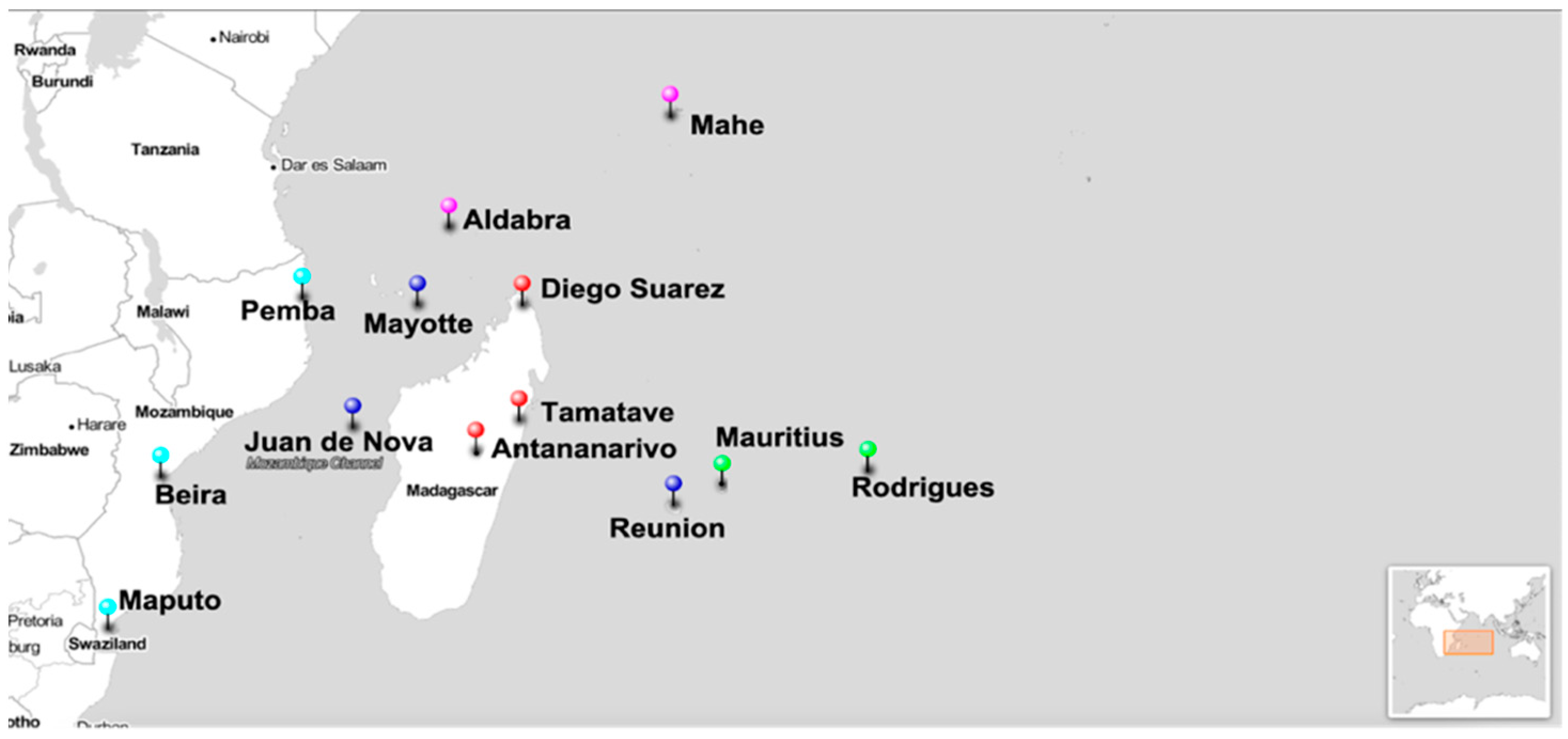
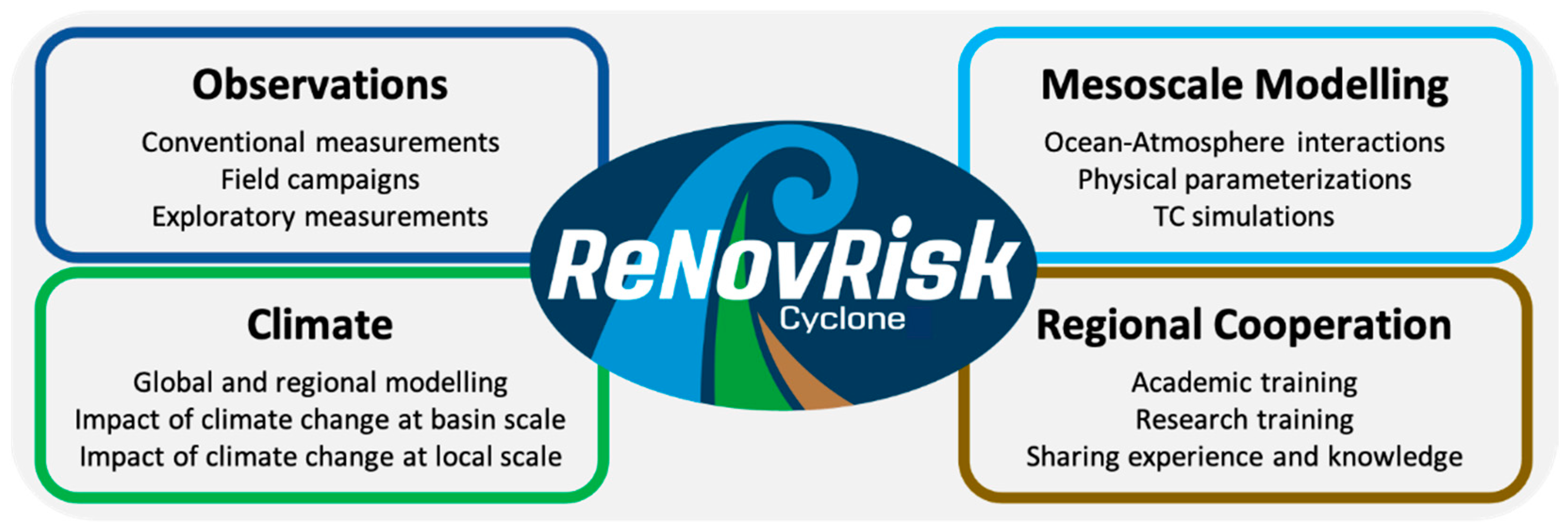
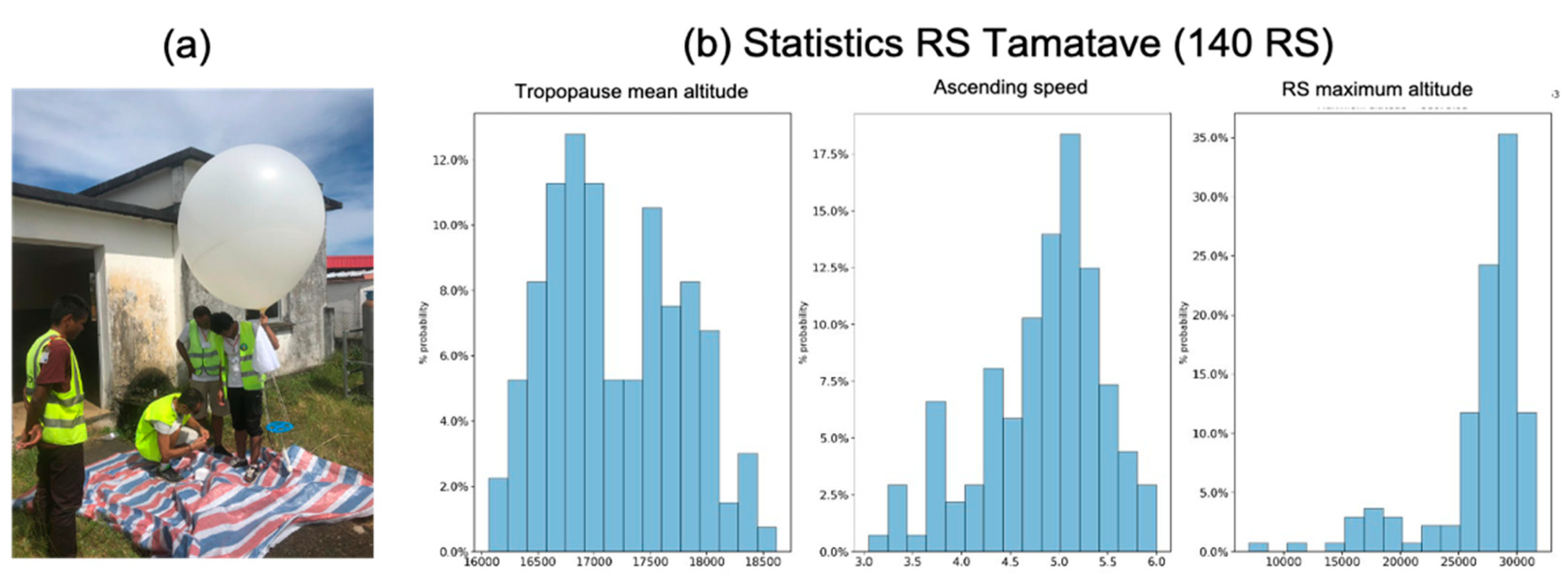
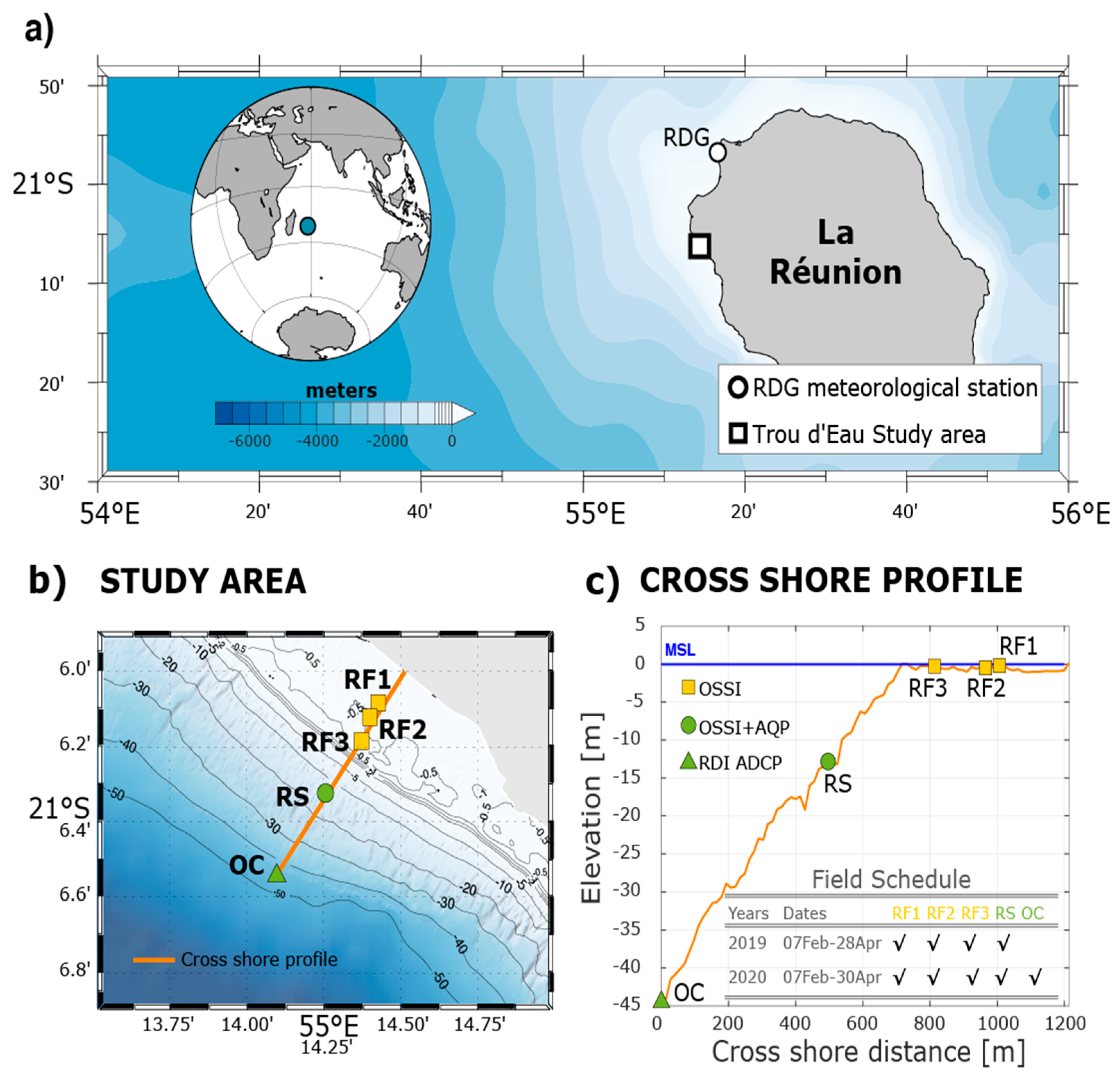
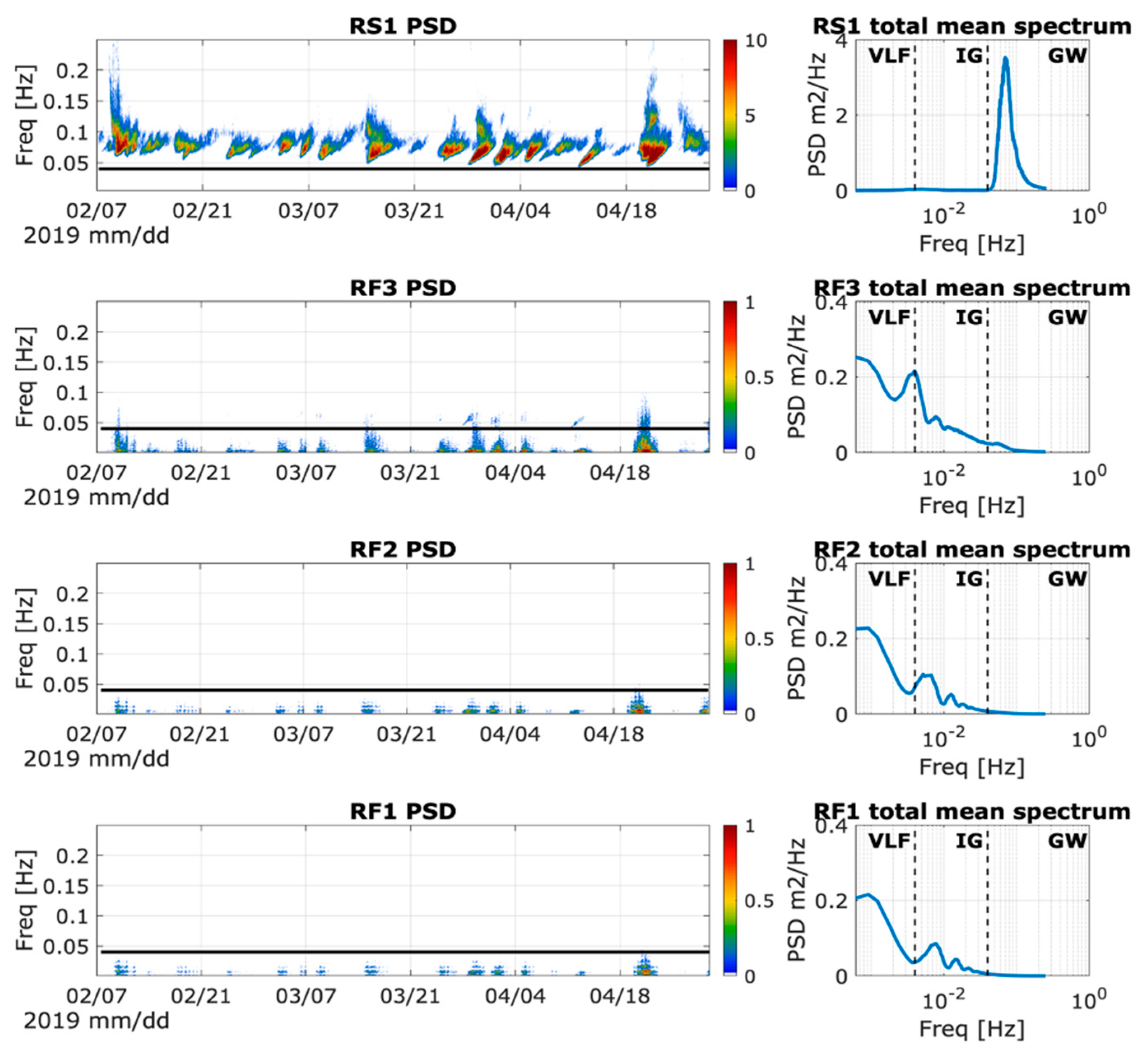
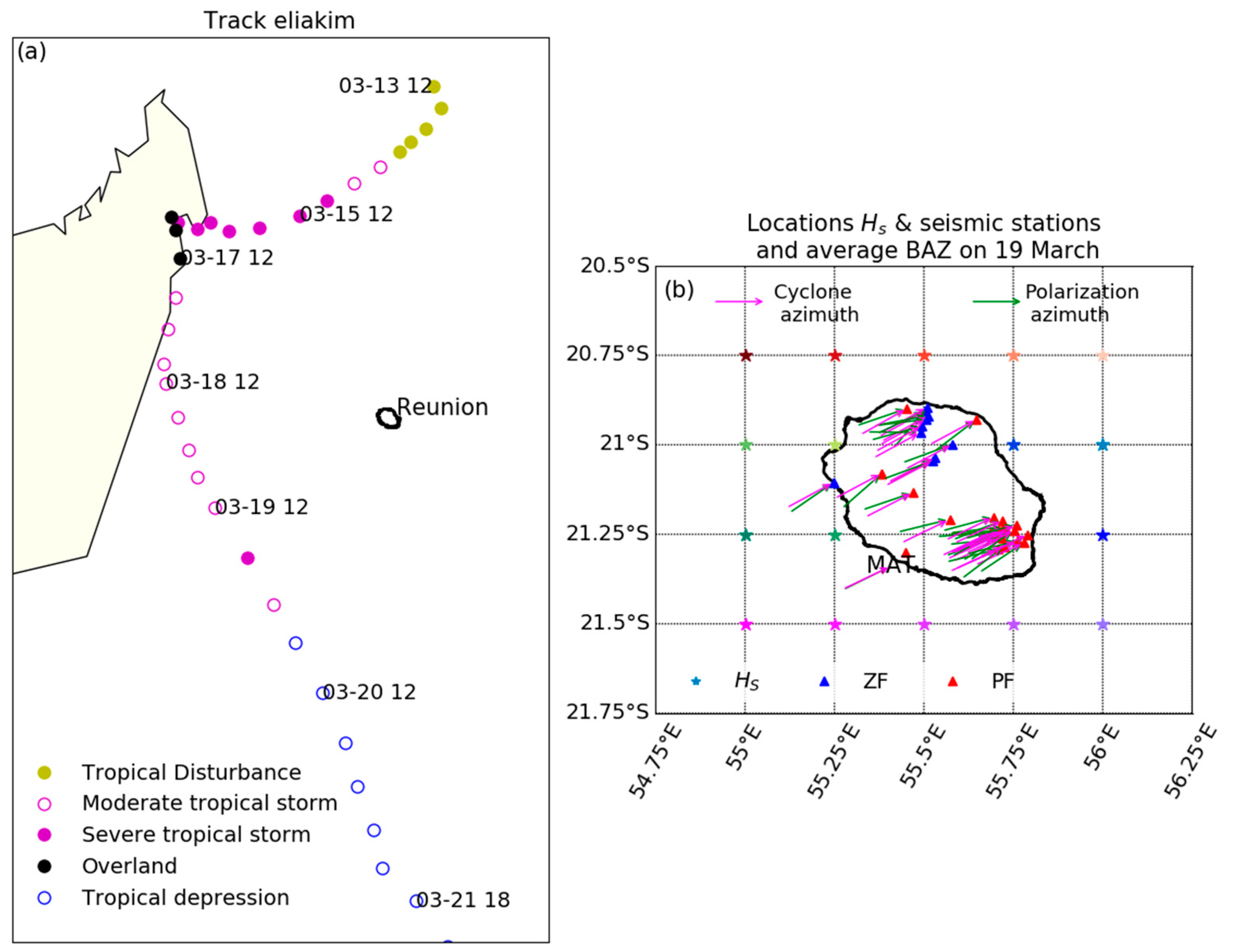
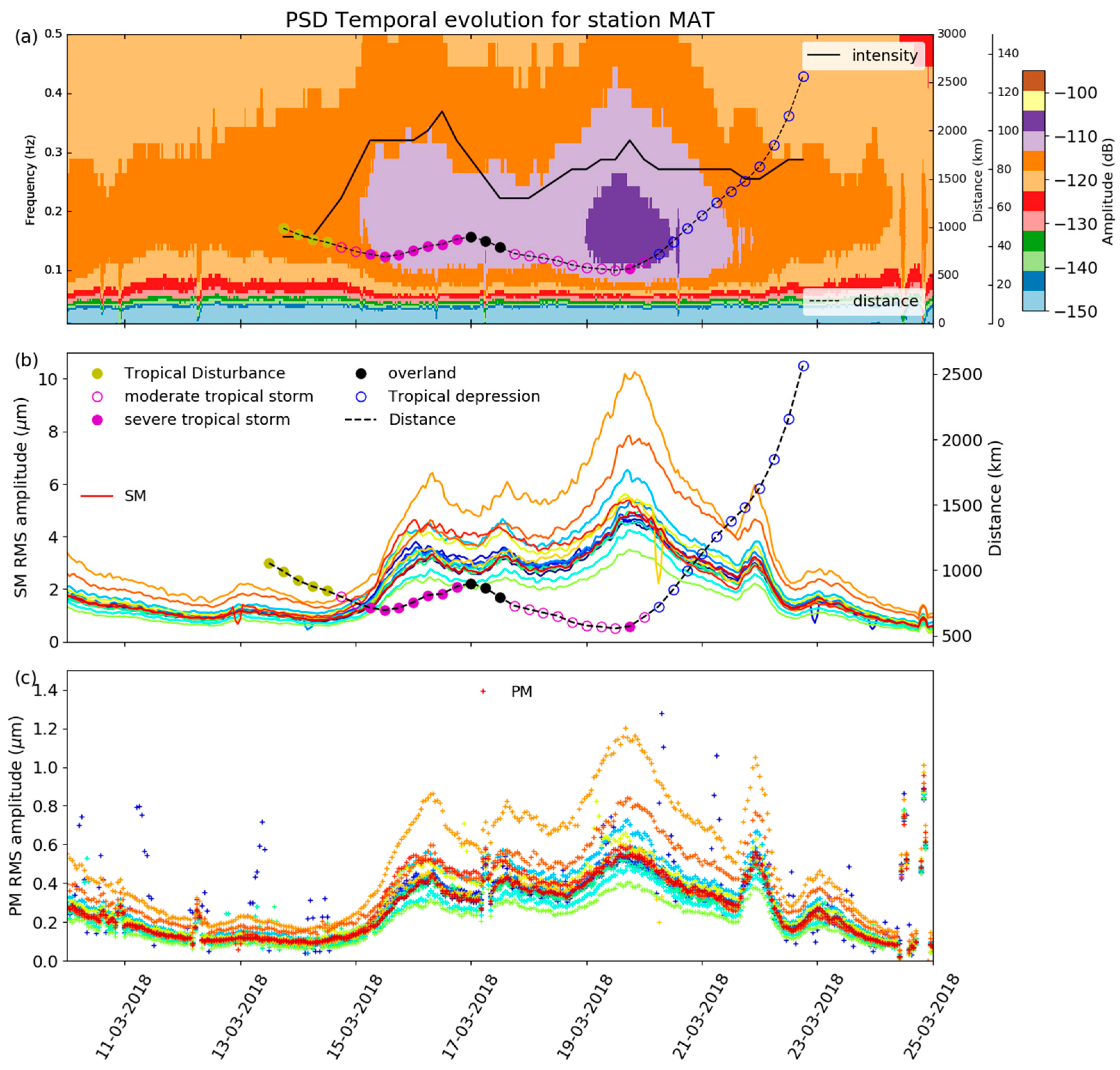
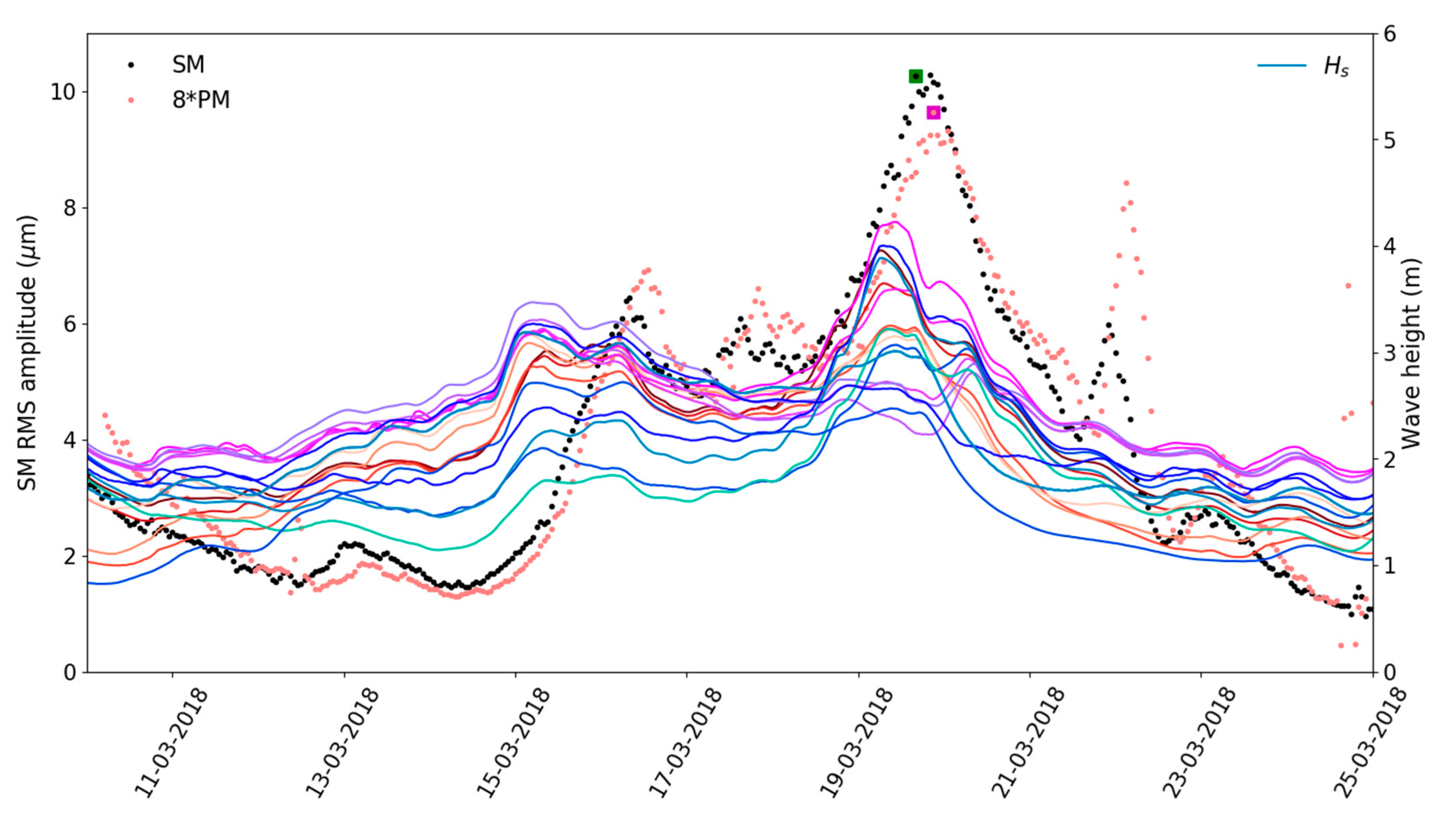
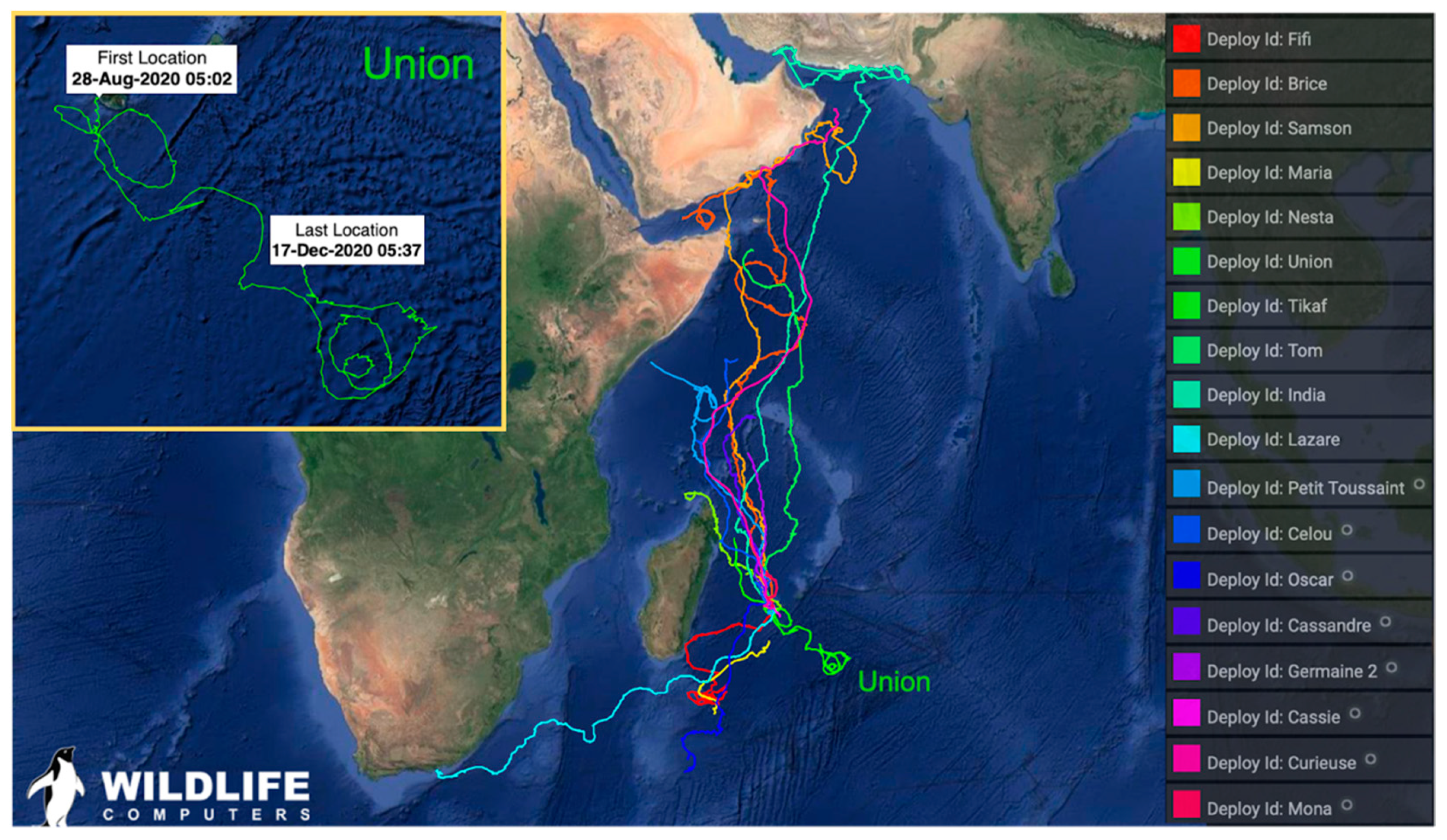
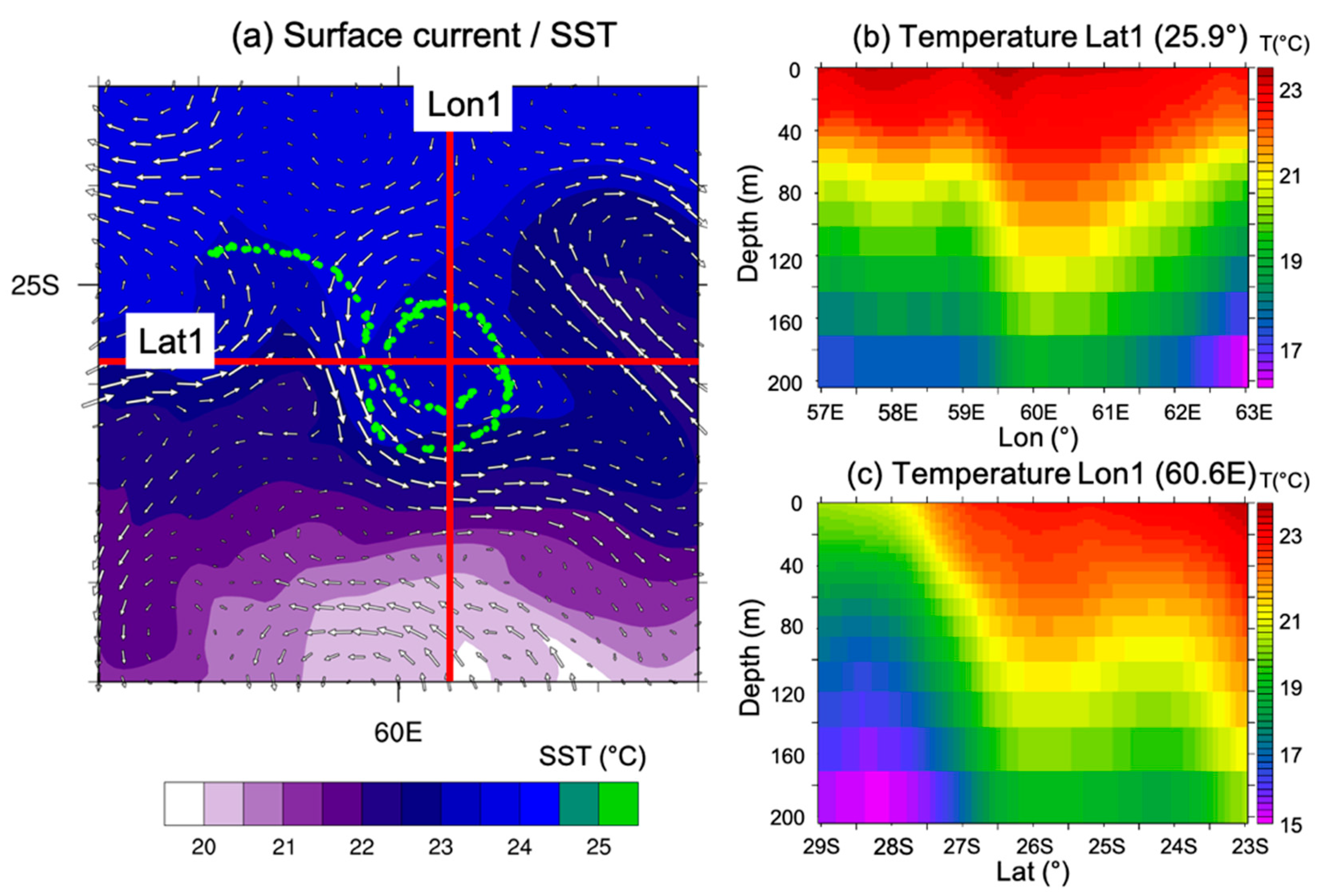
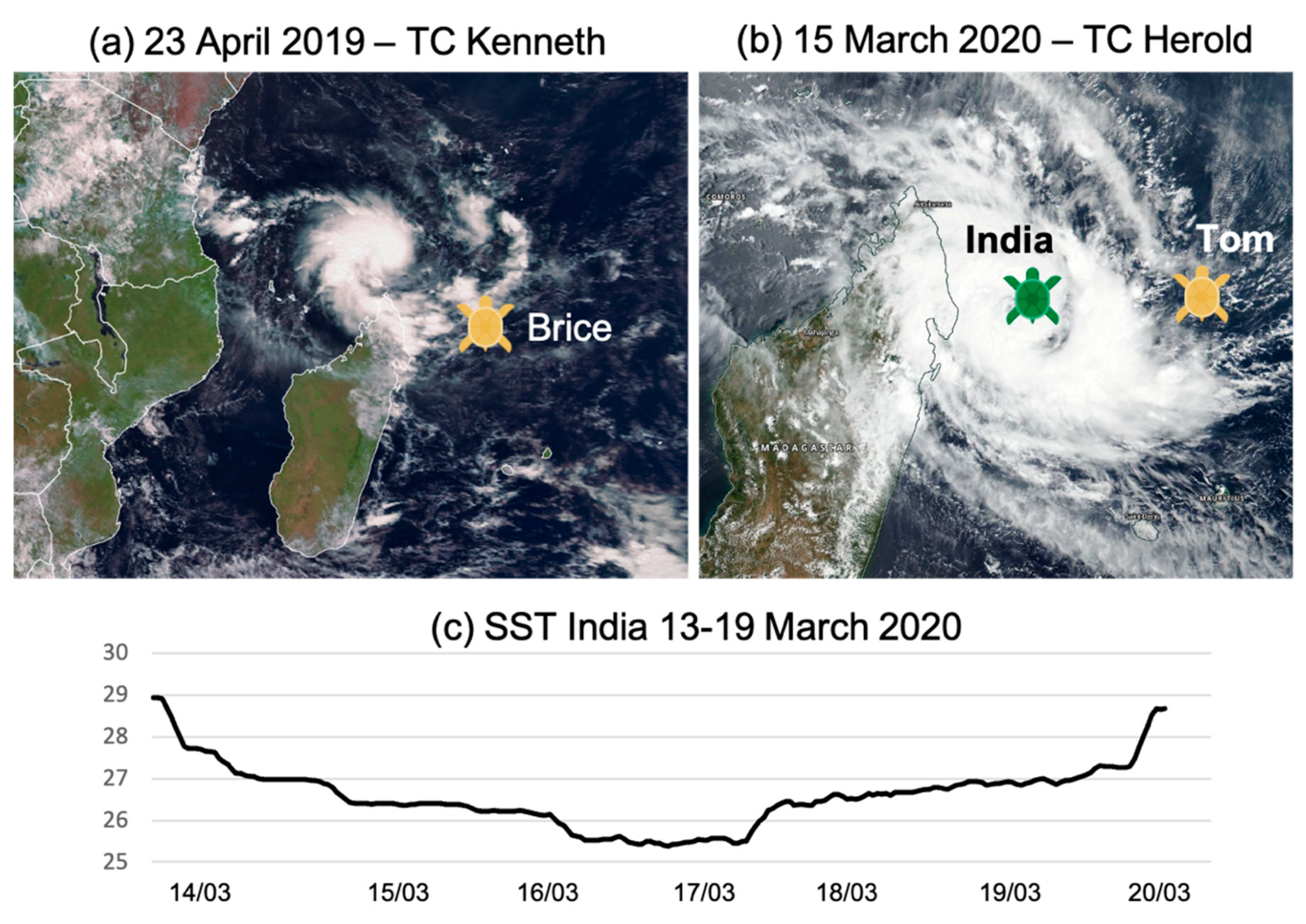
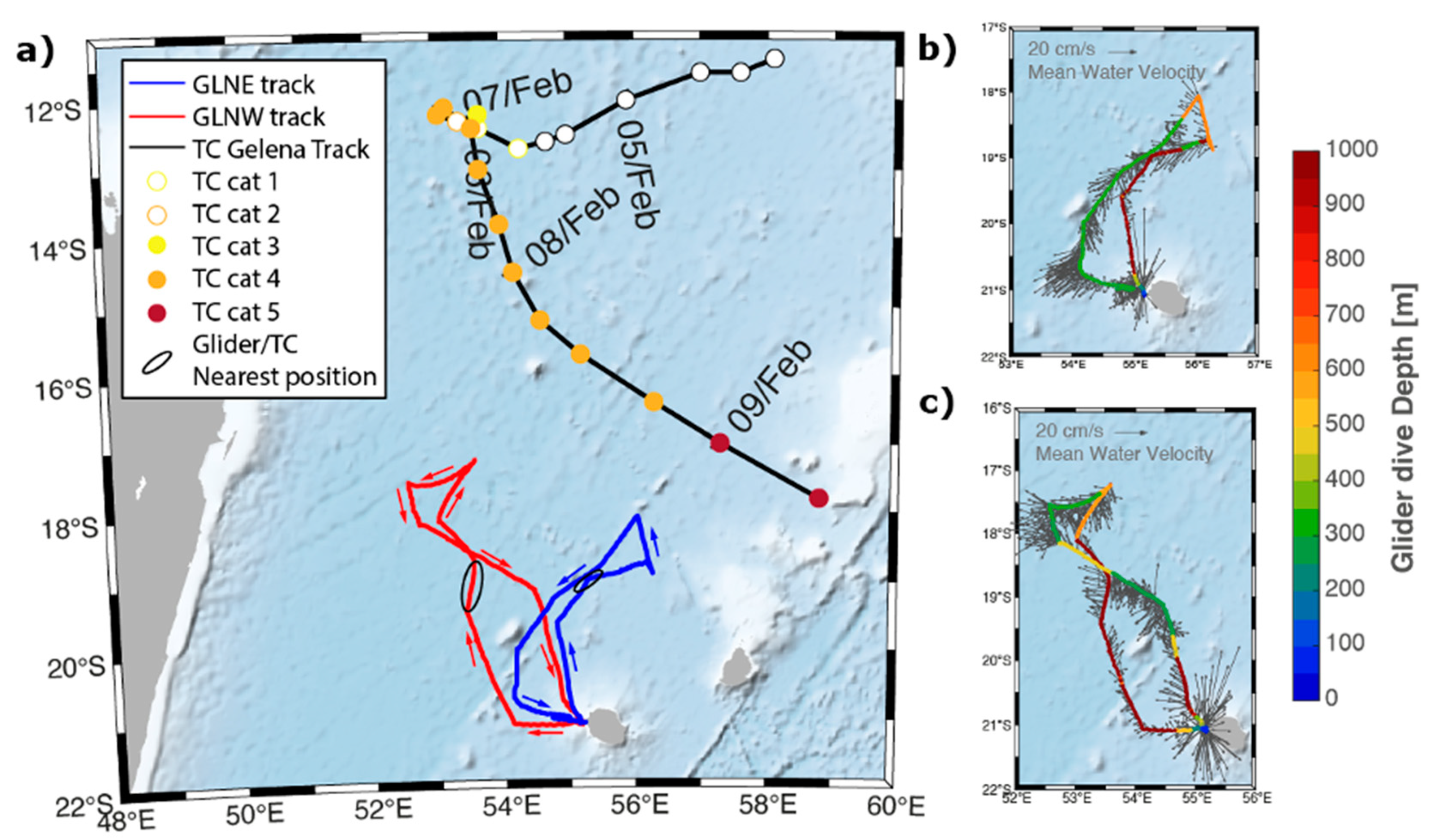
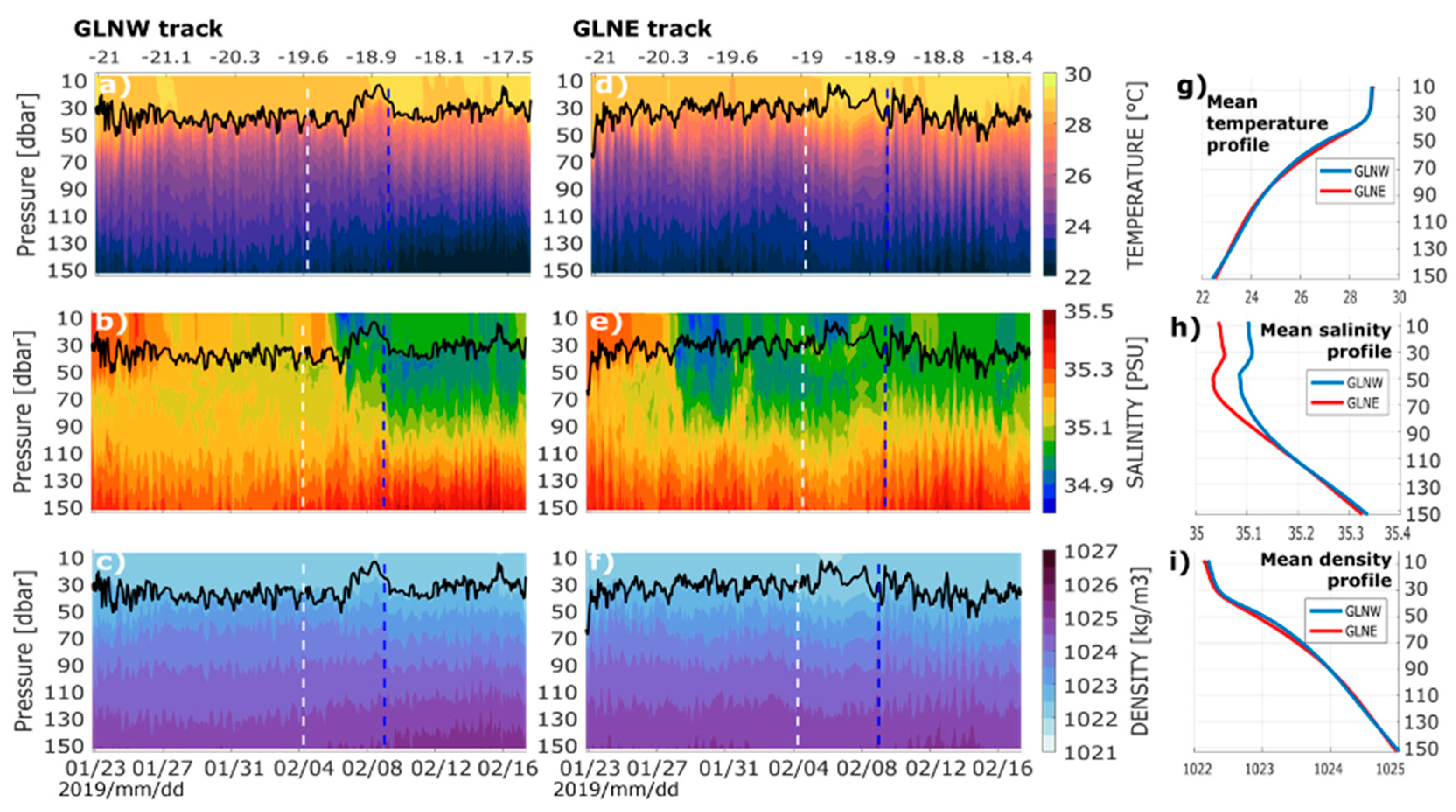
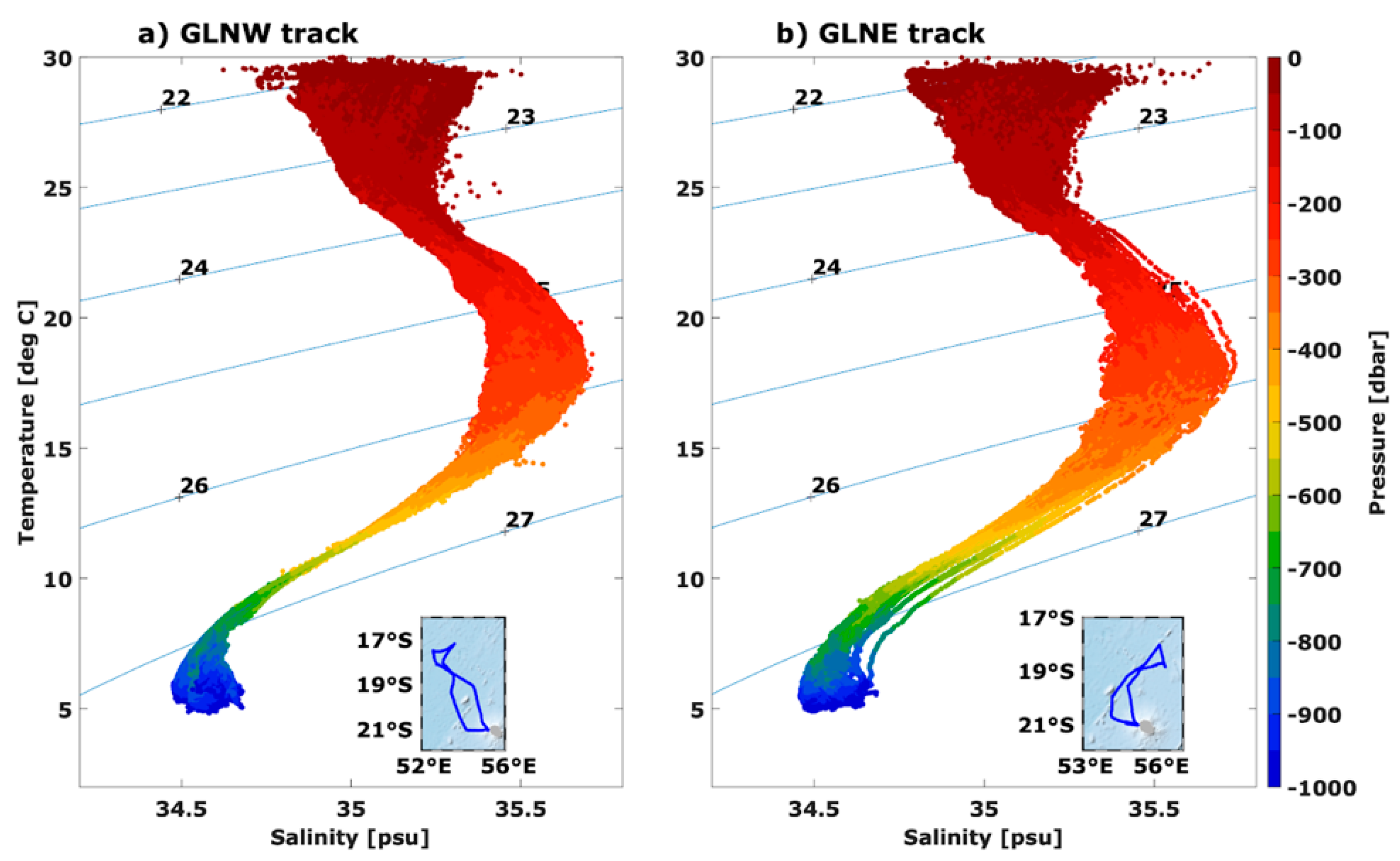
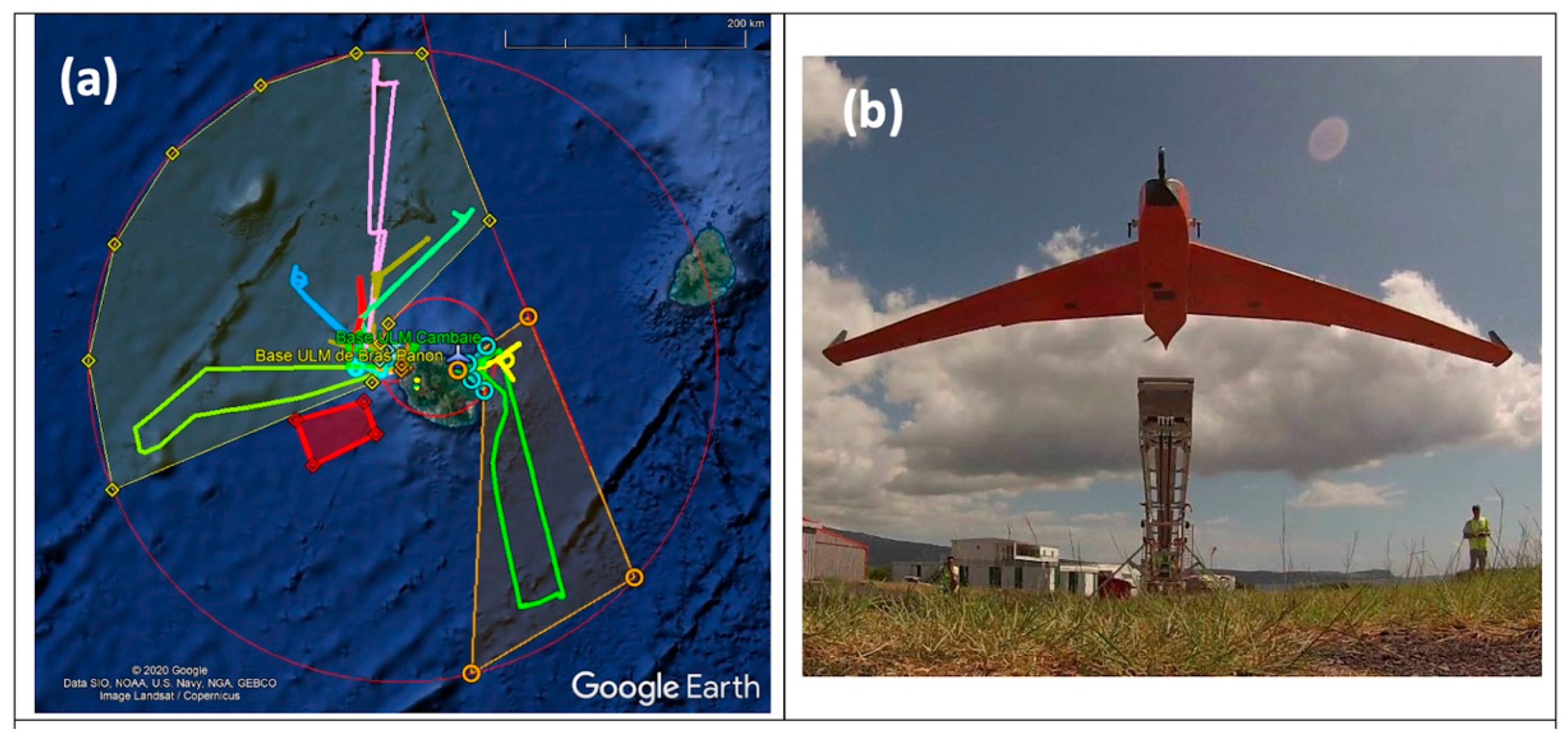
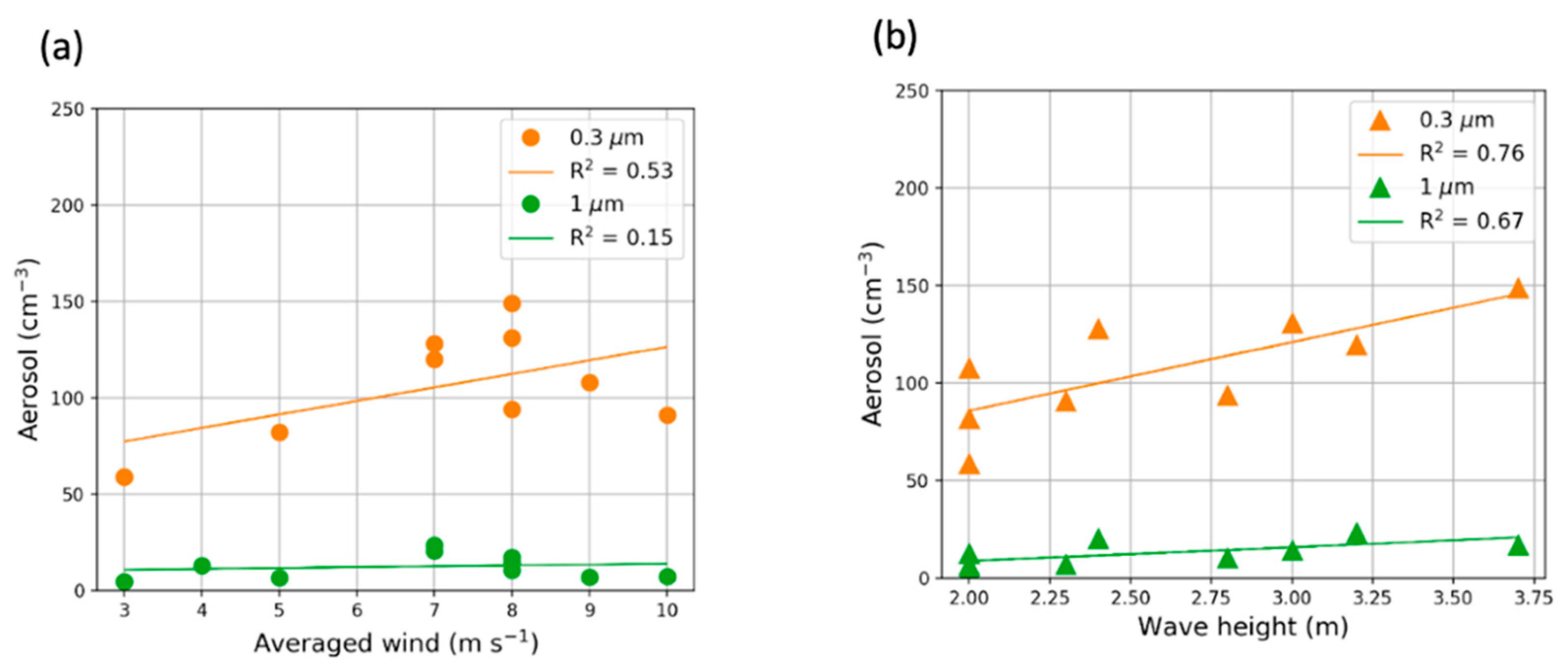
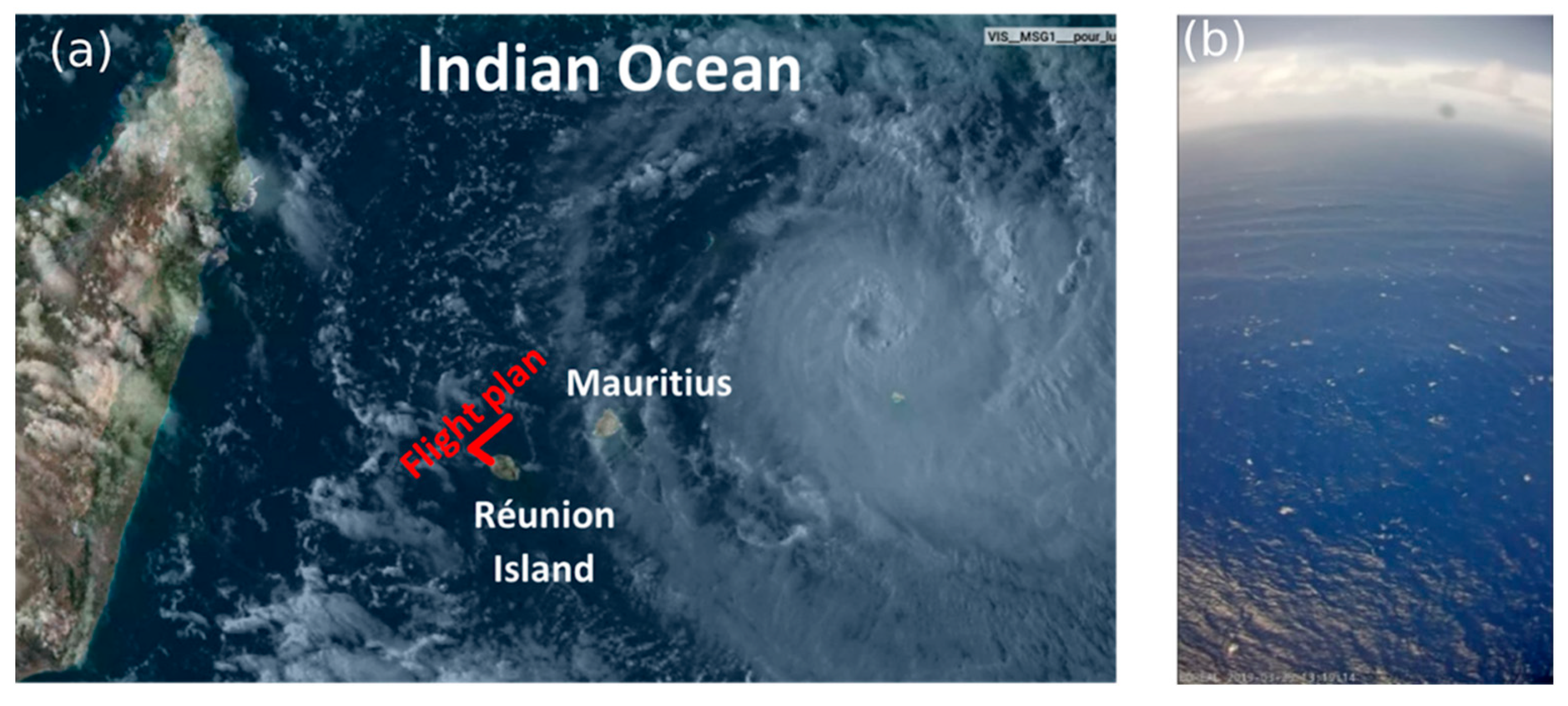
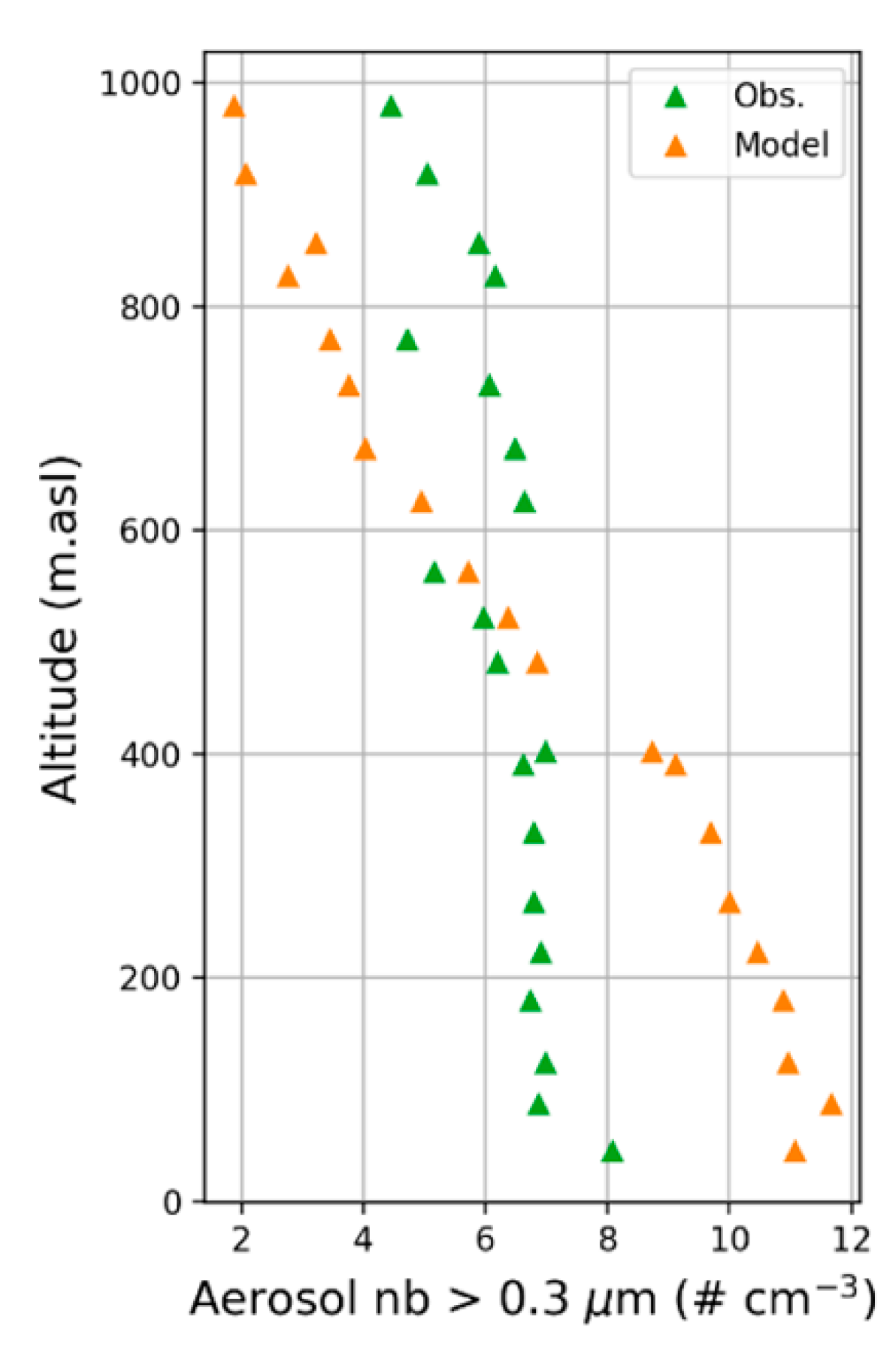


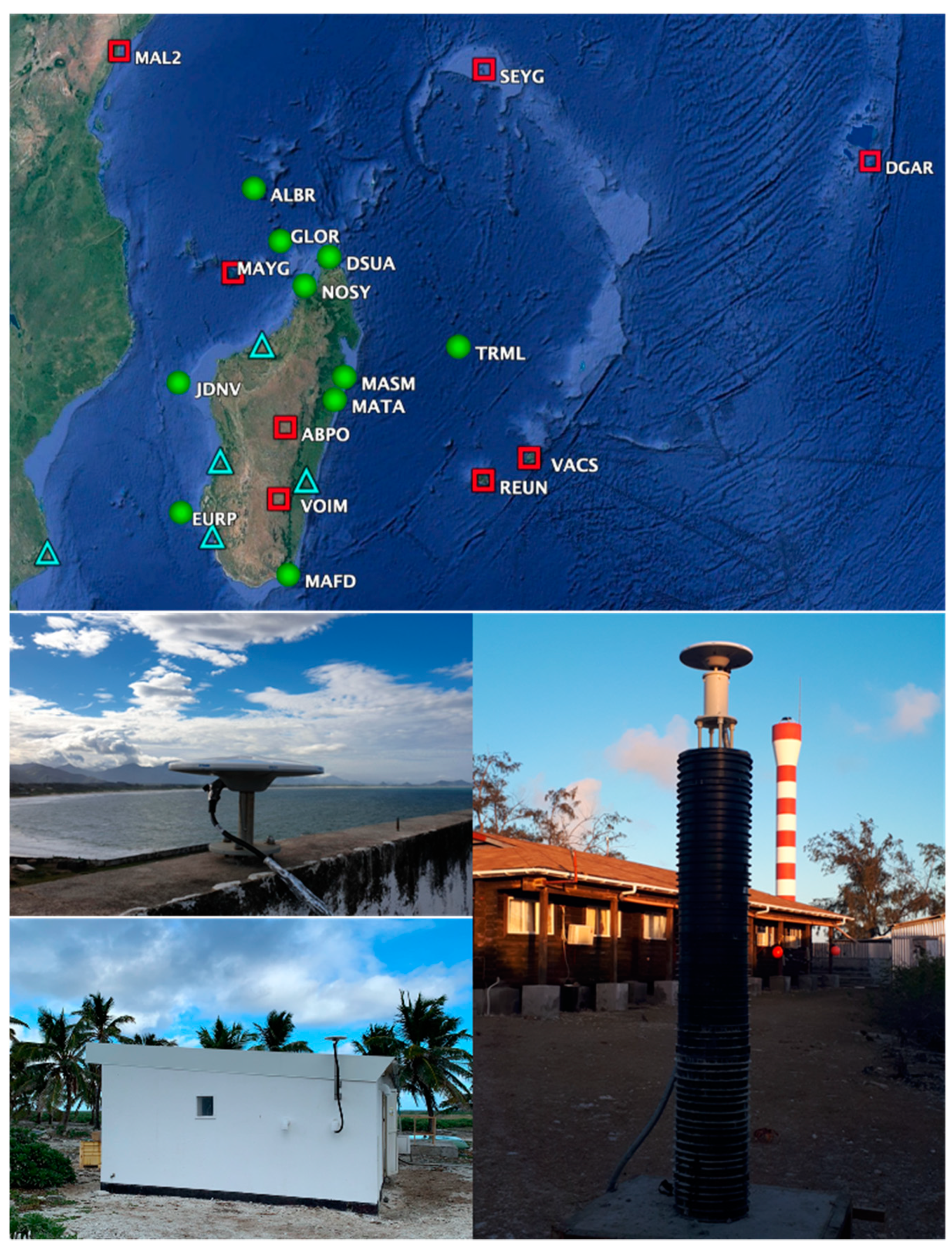
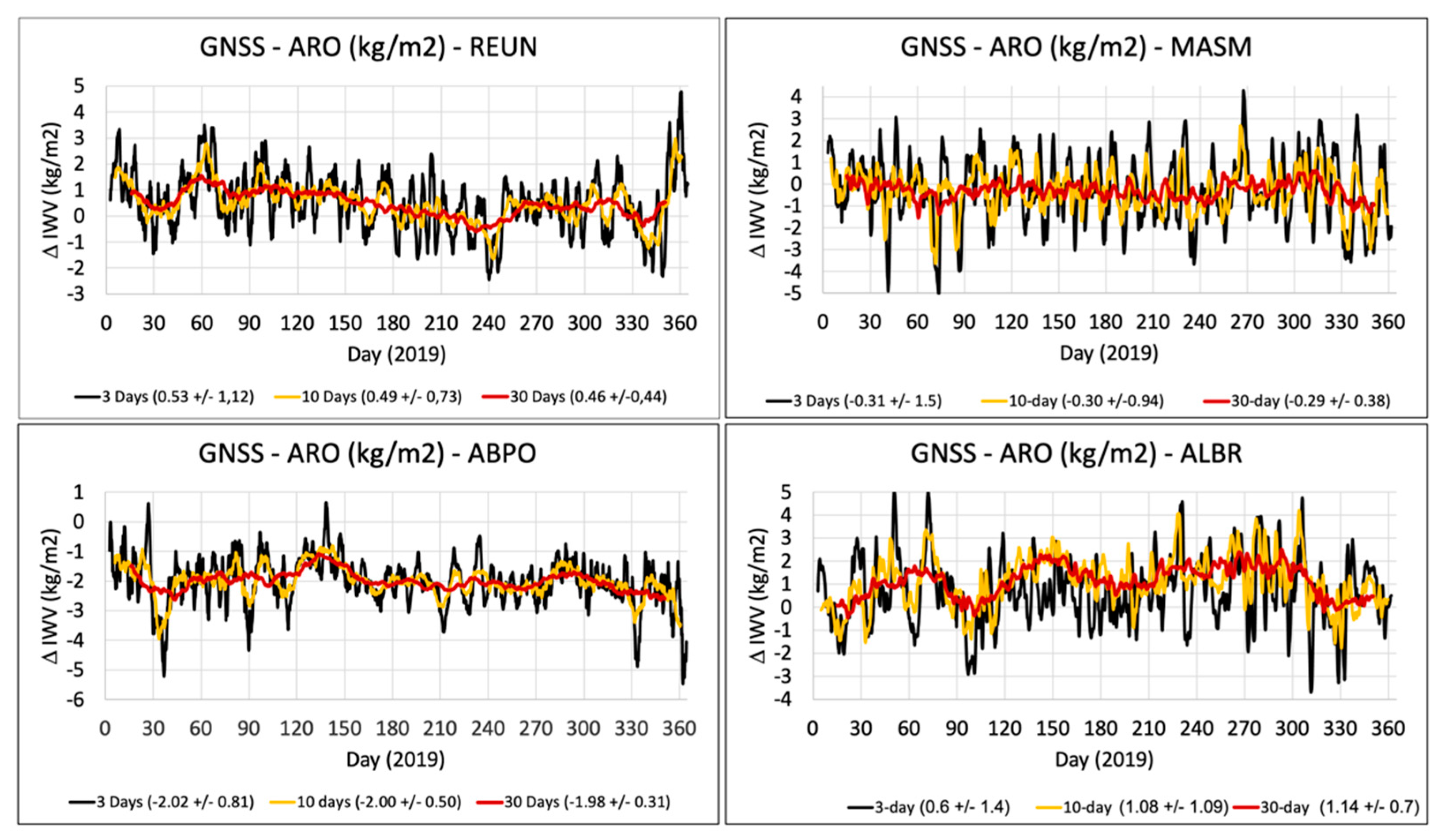
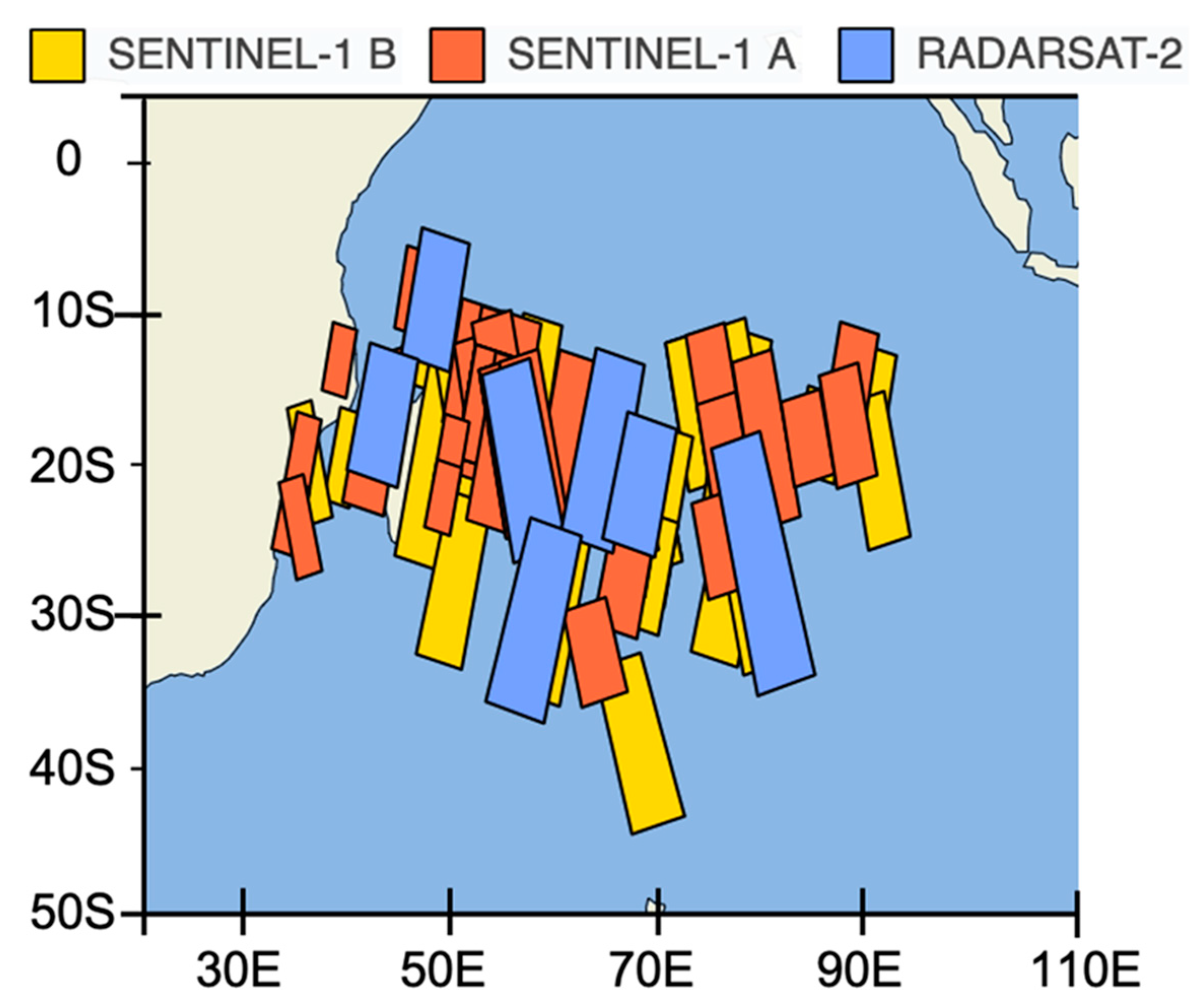
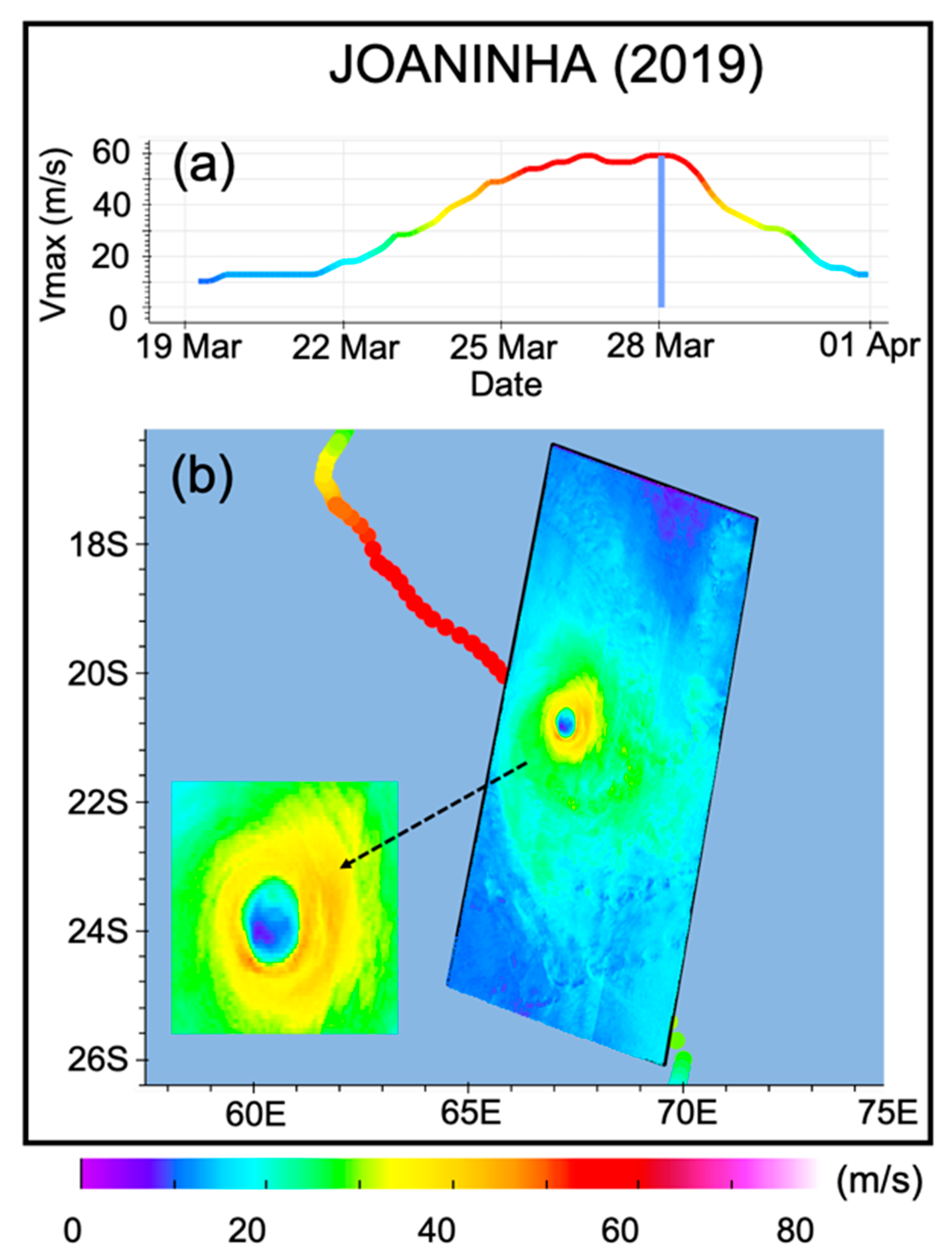
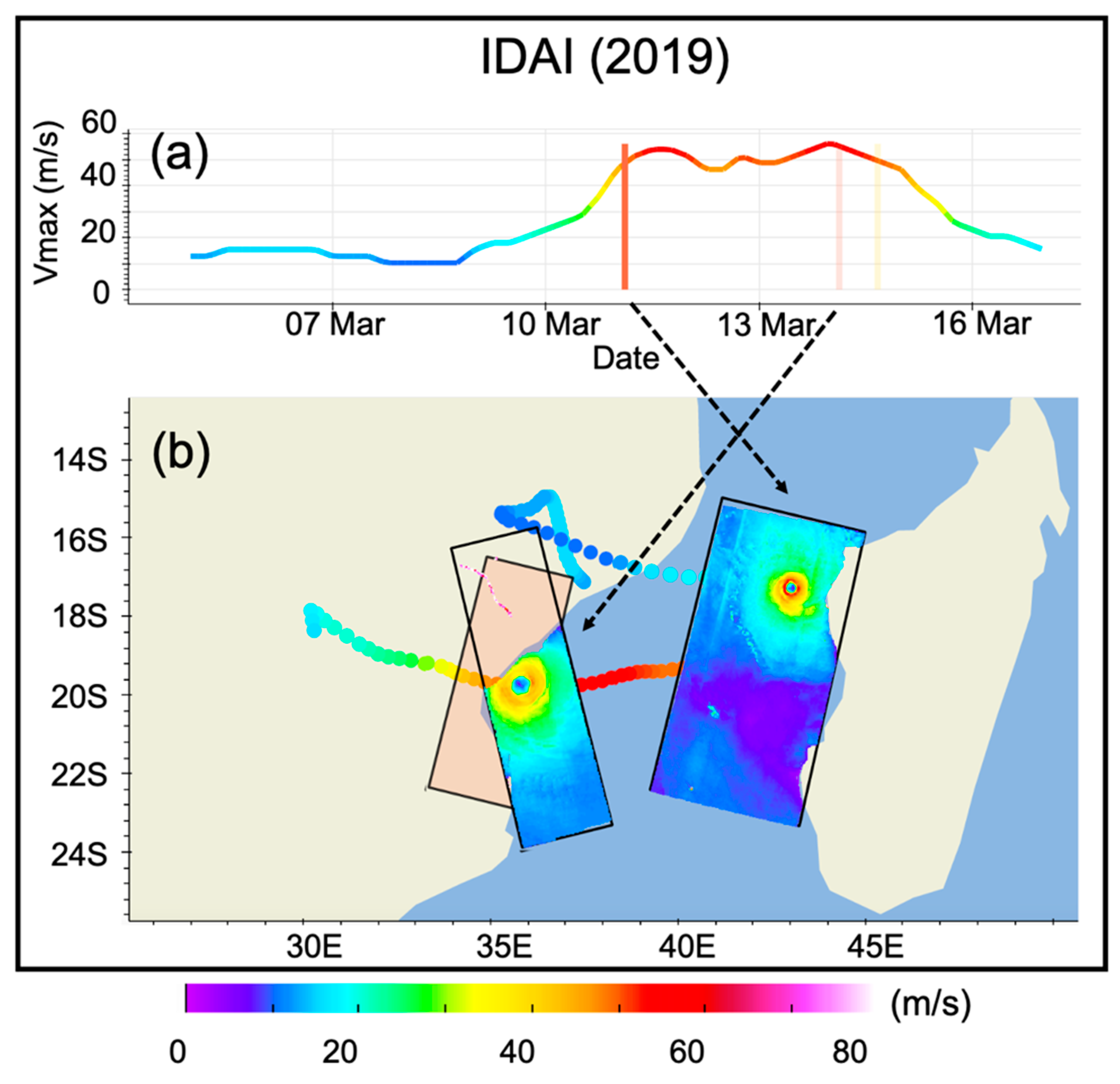
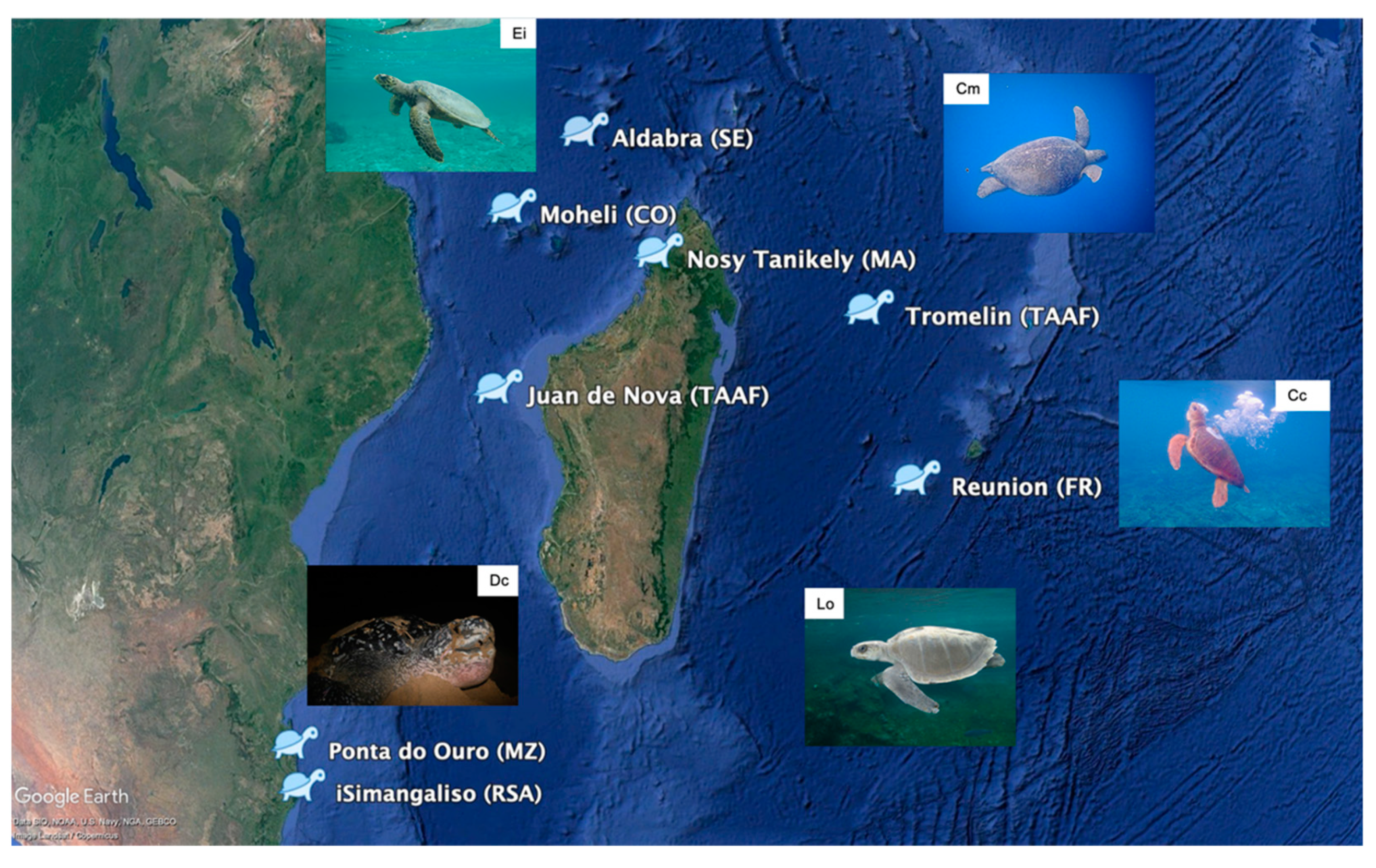
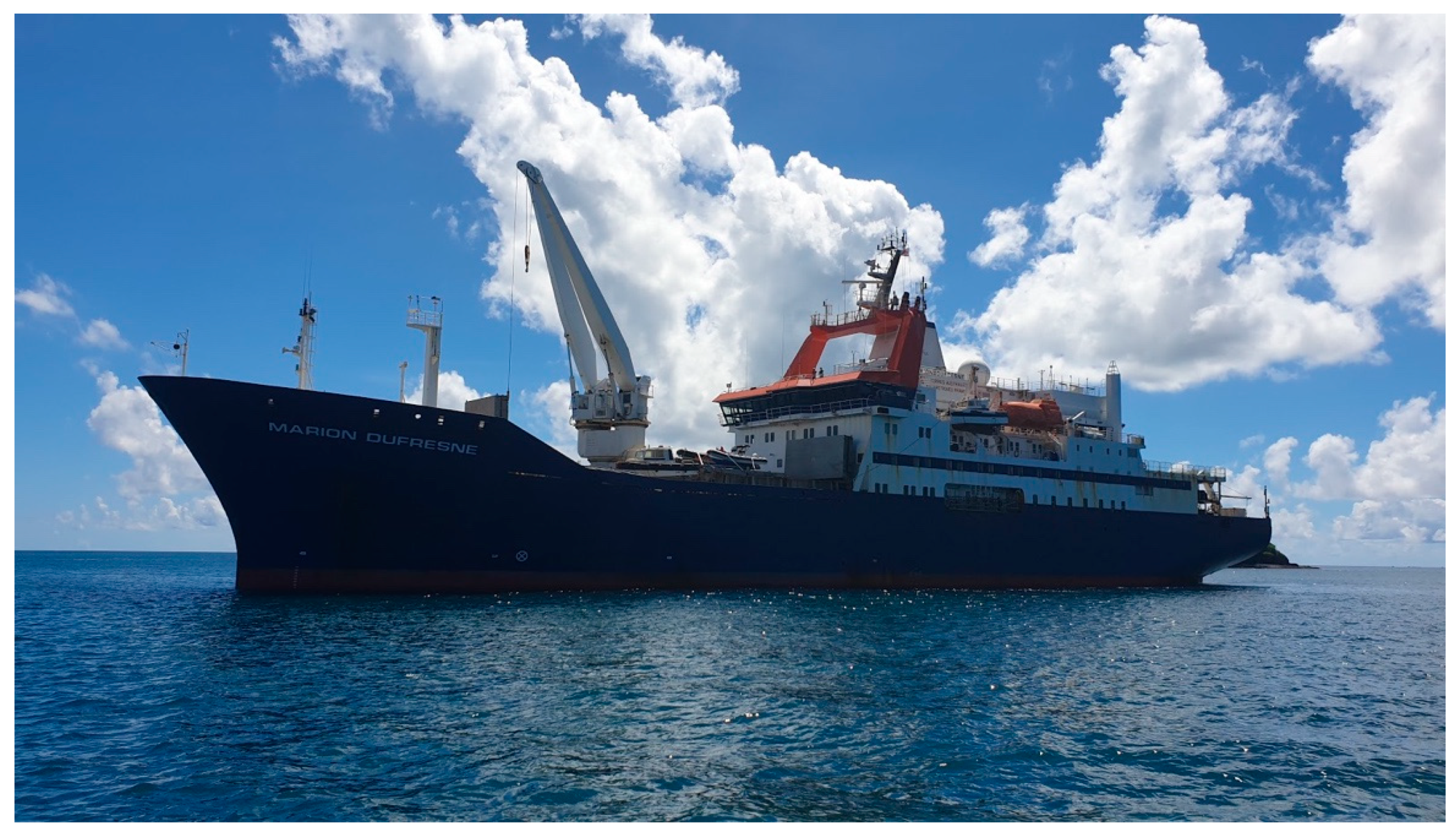
| Parameter | Instrument | Sampling | Resolution | Depth |
|---|---|---|---|---|
| GLNE | ||||
| Temperature Salinity and Depth | CTD Seabird SBE-41cp | 1/8 | 1.5 | −5 to −980 |
| Oxygen | Aanderaa Optode 5013 | - | - | - |
| Fluorescence Turbidity | Wetlabs flbbcd | - | - | - |
| GLNW | ||||
| Temperature Salinity and Depth | CTD Seabird SBE-41cp | 1/8 | 1.5 | −5 to −980 |
| Oxygen | Aanderaa Optode 4831 | 1/8 | 1.5 | −5 to −980 |
| Fluorescence Turbidity | Wetlabs flbbcd | 1/8 | 1.5 | −5 to −980 |
| Storm Name | Date | Hits | Storm Name | Date | Hits |
|---|---|---|---|---|---|
| Dineo (TC) | 02/2017 | 2 | Idaï (ITC) | 03/2019 | 3 |
| Enawo (ITC) | 03/2017 | 1 | Joaninha (ITC) | 03/2019 | 7 |
| Ava (TC) | 01/2018 | 3 | Kenneth (ITC) | 04/2019 | 1 |
| Berguitta (ITC) | 01/2018 | 4 | Lorna (TC) | 04/2019 | 4 |
| Cebile (ITC) | 01/2018 | 8 | Belna (TC) | 12/2019 | 5 |
| Dumazile (ITC) | 03/2018 | 5 | Calvinia (TC) | 12/2019 | 1 |
| Eliakim (TS) | 03/2018 | 1 | Diane (TS) | 01/2020 | 1 |
| Alcide (ITC) | 11/2018 | 1 | Francisco (TS) | 02/2020 | 1 |
| Kenanga (ITC) | 12/2018 | 2 | Herold (ITC) | 03/2020 | 1 |
| Gelena (ITC) | 02/2019 | 4 | * Chalane (TS) | 12/2021 | 3 |
| Haleh (ITC) | 03/2019 | 6 | * Eloise (TC) | 01/2021 | 2 |
Publisher’s Note: MDPI stays neutral with regard to jurisdictional claims in published maps and institutional affiliations. |
© 2021 by the authors. Licensee MDPI, Basel, Switzerland. This article is an open access article distributed under the terms and conditions of the Creative Commons Attribution (CC BY) license (https://creativecommons.org/licenses/by/4.0/).
Share and Cite
Bousquet, O.; Barruol, G.; Cordier, E.; Barthe, C.; Bielli, S.; Calmer, R.; Rindraharisaona, E.; Roberts, G.; Tulet, P.; Amelie, V.; et al. Impact of Tropical Cyclones on Inhabited Areas of the SWIO Basin at Present and Future Horizons. Part 1: Overview and Observing Component of the Research Project RENOVRISK-CYCLONE. Atmosphere 2021, 12, 544. https://doi.org/10.3390/atmos12050544
Bousquet O, Barruol G, Cordier E, Barthe C, Bielli S, Calmer R, Rindraharisaona E, Roberts G, Tulet P, Amelie V, et al. Impact of Tropical Cyclones on Inhabited Areas of the SWIO Basin at Present and Future Horizons. Part 1: Overview and Observing Component of the Research Project RENOVRISK-CYCLONE. Atmosphere. 2021; 12(5):544. https://doi.org/10.3390/atmos12050544
Chicago/Turabian StyleBousquet, Olivier, Guilhem Barruol, Emmanuel Cordier, Christelle Barthe, Soline Bielli, Radiance Calmer, Elisa Rindraharisaona, Gregory Roberts, Pierre Tulet, Vincent Amelie, and et al. 2021. "Impact of Tropical Cyclones on Inhabited Areas of the SWIO Basin at Present and Future Horizons. Part 1: Overview and Observing Component of the Research Project RENOVRISK-CYCLONE" Atmosphere 12, no. 5: 544. https://doi.org/10.3390/atmos12050544
APA StyleBousquet, O., Barruol, G., Cordier, E., Barthe, C., Bielli, S., Calmer, R., Rindraharisaona, E., Roberts, G., Tulet, P., Amelie, V., Fleischer-Dogley, F., Mavume, A., Zucule, J., Zakariasy, L., Razafindradina, B., Bonnardot, F., Singh, M., Lees, E., Durand, J., ... Marquestaut, N. (2021). Impact of Tropical Cyclones on Inhabited Areas of the SWIO Basin at Present and Future Horizons. Part 1: Overview and Observing Component of the Research Project RENOVRISK-CYCLONE. Atmosphere, 12(5), 544. https://doi.org/10.3390/atmos12050544






